Uruguay is home to a diverse range of birds, with over 500 species having been recorded in the country. From the majestic Andean condor to the striking yellow-billed cardinal, Uruguay is a paradise for birdwatchers.
Whether you’re an experienced birder or a beginner, Uruguay offers a wealth of opportunities to observe its incredible feathered inhabitants. From its lush rainforests to its sprawling wetlands, Uruguay is a haven for birds of all sizes and shapes.
This article will provide an overview of some of the most interesting and unique birds that can be found in Uruguay.
1. Rufous Hornero
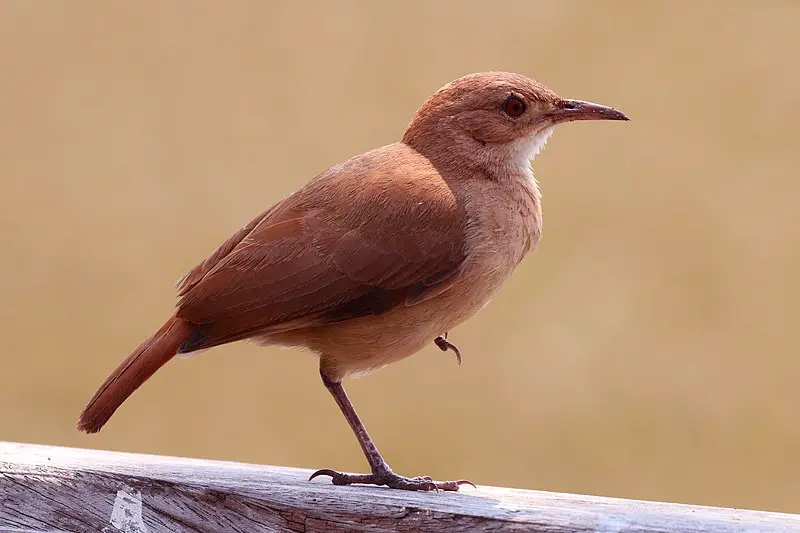
The Rufous Hornero is a small ovenbird found in eastern South America and is the national bird of Argentina. It has adapted to human environments such as pastures, agricultural land and second-growth scrub areas, making it synanthropic.
Its range stretches from midwestern Brazil to southern Bolivia, Paraguay, Uruguay and northern Argentina.
The species is easily identifiable by its rusty red plumage with dark streaks on the back of its neck along with white underparts that have black spots near their edges.
This medium-sized bird has impressive mud dome nests at top of trees or artificial structures like power poles where they lay two eggs each season which are incubated for about three weeks until hatching takes place.
They feed mainly on insects but also eat fruits when available during winter monthsScientific classification:
| Kingdom | Animalia |
| Phylum | Chordata |
| Class | Aves |
| Order | Passeriformes |
| Family | Furnariidae |
| Genus | Furnarius |
| Species | F. rufus |
2. Great Kiskadee
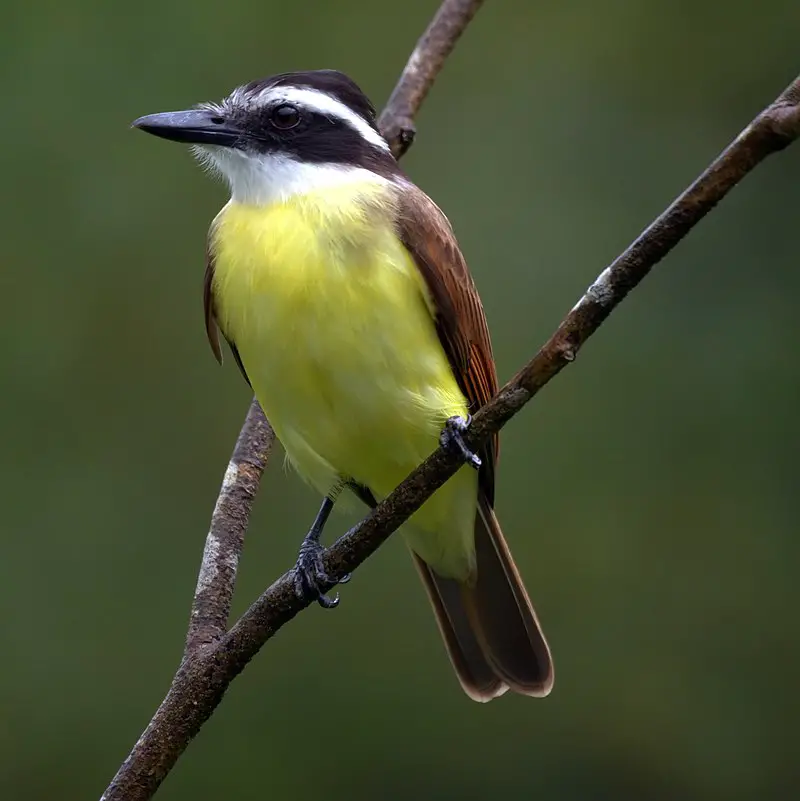
The Great Kiskadee is a passerine bird belonging to the Tyrant Flycatcher family.
It has an unmistakable yellow and black plumage, making it easily recognizable in its native habitats of Belize, Texas, Argentina and Brazil where it is known as Bem-te-vi or Benteveo respectively.
The species inhabits open woodland with some tall trees such as cultivation areas and other places surrounding human dwellings.
This adaptable bird feeds mainly on insects but also consumes fruit for energy when needed.
Its call resembles laughter which adds to its charm among avid nature watchers who are always delighted by their presence.
A unique feature that sets this species apart from others is that they can imitate songs of other birds accurately too.Scientific classification:
| Kingdom | Animalia |
| Phylum | Chordata |
| Class | Aves |
| Order | Passeriformes |
| Family | Tyrannidae |
| Genus | Pitangus Swainson, 1827 |
| Species | P. sulphuratus |
3. Southern Lapwing
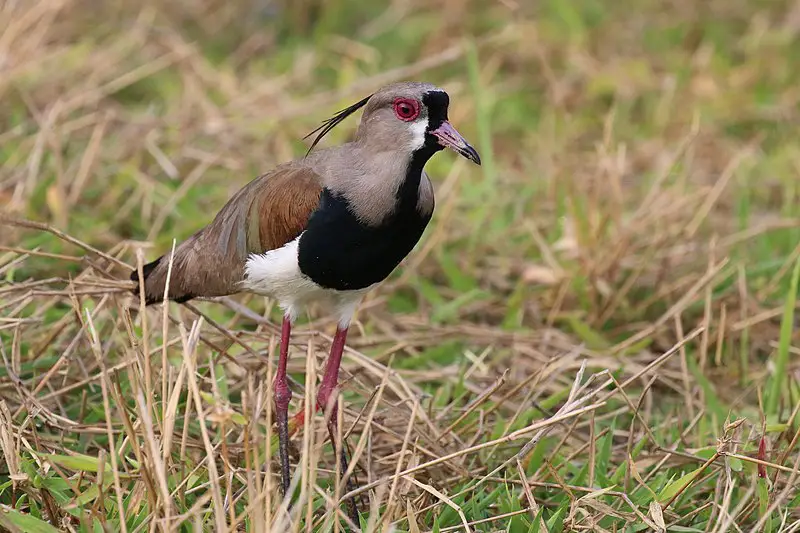
The Southern lapwing, also known as quero-quero in Brazil or tero in Argentina and Uruguay, is a wader that can be found throughout South America.
It inhabits open areas like grasslands and fields but avoids heavily forested regions such as the Amazon basin.
This bird has an unmistakable appearance with its black-and-white plumage contrasting against its bright yellow bill and legs.
The male’s feathers are more vibrant than those of the female, making them easily distinguishable from each other.
They feed on worms and insects which they search for by probing their long bills into soft ground while walking around looking for food.
Lapwings are highly territorial birds who will protect their nests fiercely from any potential predators or intruders.Scientific classification:
| Kingdom | Animalia |
| Phylum | Chordata |
| Class | Aves |
| Order | Charadriiformes |
| Family | Charadriidae |
| Genus | Vanellus |
| Species | V. chilensis |
4. Wattled Jacana
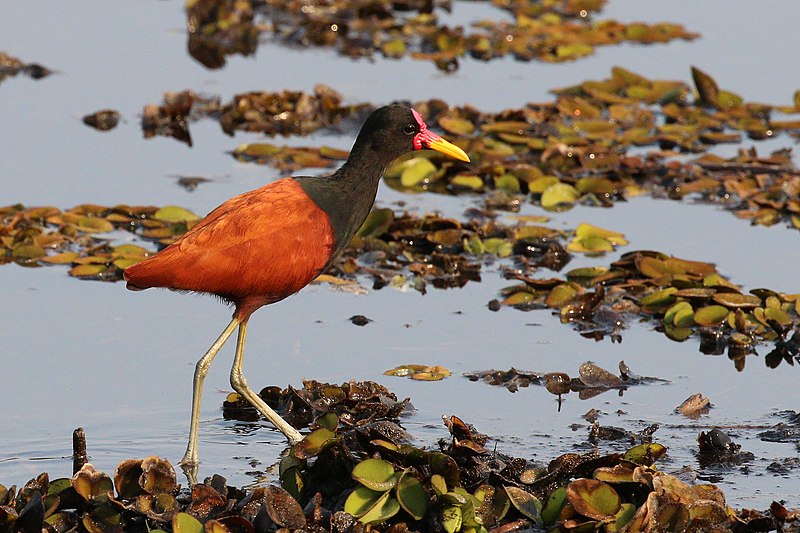
The Wattled Jacana is a stunning bird from central and south America. It has long legs, a black head with yellow wattles at each side, and striking chestnut brown wings.
This wader builds its nest on the surface of ponds or lakes using floating vegetation such as lily pads to anchor it in place – usually with four eggs that are darkly marked.
The male takes primary responsibility for incubation of these eggs between his wings, while the female will take care of her chicks once they hatch out.
These birds feed mainly on aquatic insects but also small fish and amphibians if available.
Overall this species is an interesting and attractive addition to any wetland habitat.Scientific classification:
| Kingdom | Animalia |
| Phylum | Chordata |
| Class | Aves |
| Order | Charadriiformes |
| Family | Jacanidae |
| Genus | Jacana |
| Species | J. jacana |
5. Rufous-Bellied Thrush
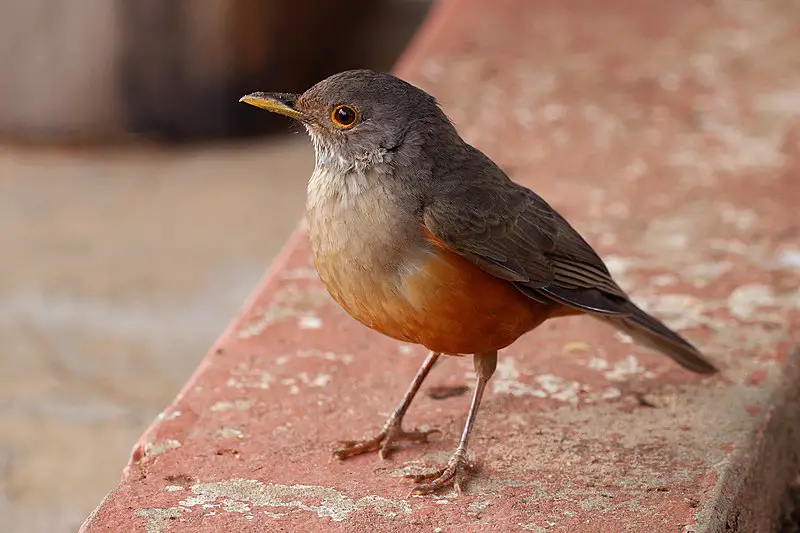
The Rufous-bellied Thrush is a songbird of the Turdidae family, commonly found in Brazil, Bolivia, Paraguay, Uruguay and parts of Argentina. It has brownish orange feathers on its back and throat while it’s underside is bright yellow.
This species likes to inhabit open woodland areas such as lowland evergreen forests or mangroves where they feed on insects like beetles, ants and caterpillars.
They are also known for their beautiful songs which consist of whistles with staccato notes at the end that make them easily identifiable amongst other thrushes.
The populations have remained relatively stable over time but due to deforestation there has been some decline in numbers so conservation efforts need to be implemented if we want this species around for many more years to come.Scientific classification:
| Kingdom | Animalia |
| Phylum | Chordata |
| Class | Aves |
| Order | Passeriformes |
| Family | Turdidae |
| Genus | Turdus |
| Species | T. rufiventris |
6. Greater Rhea
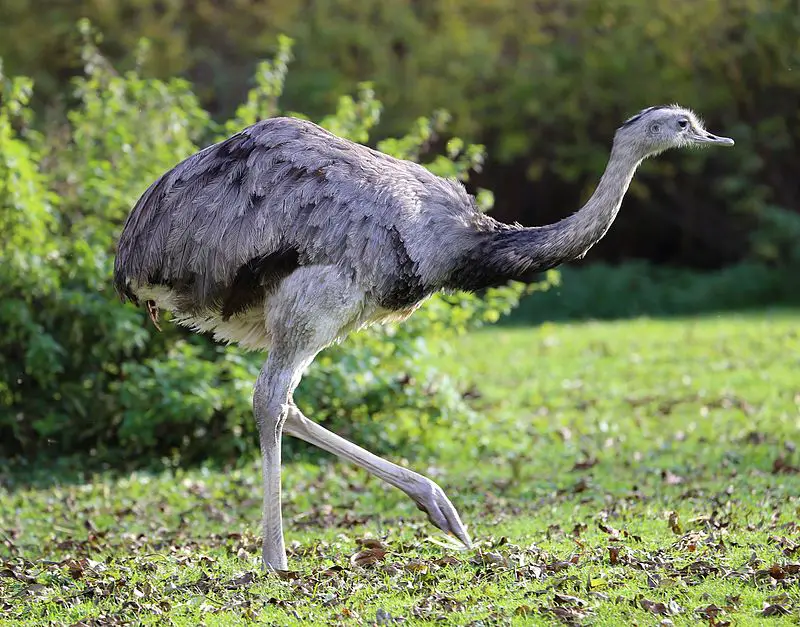
The Greater Rhea is a flightless bird native to eastern South America. It has many different names, including the Grey, Common or American Rhea, Ema (Portuguese) and Ñandú (Guaraní and Spanish).
This species of rhea lives in Brazil, Bolivia, Argentina Paraguay and Uruguay. It inhabits open areas such as grasslands with scattered shrubs and trees.
They are mostly active during the day when they feed on plants like grasses as well as small animals like insects.
The greater rheas can also be seen running away from potential predators like foxes or coyotes at high speeds up to 70 km/h.
These majestic birds have an impressive wingspan that reaches 6 feet across – making them one of the largest flying birds in their region.Scientific classification:
| Kingdom | Animalia |
| Phylum | Chordata |
| Class | Aves |
| Infraclass | Palaeognathae |
| Order | Rheiformes |
| Family | Rheidae |
| Genus | Rhea |
| Species | R. americana |
7. Red-Crested Cardinal
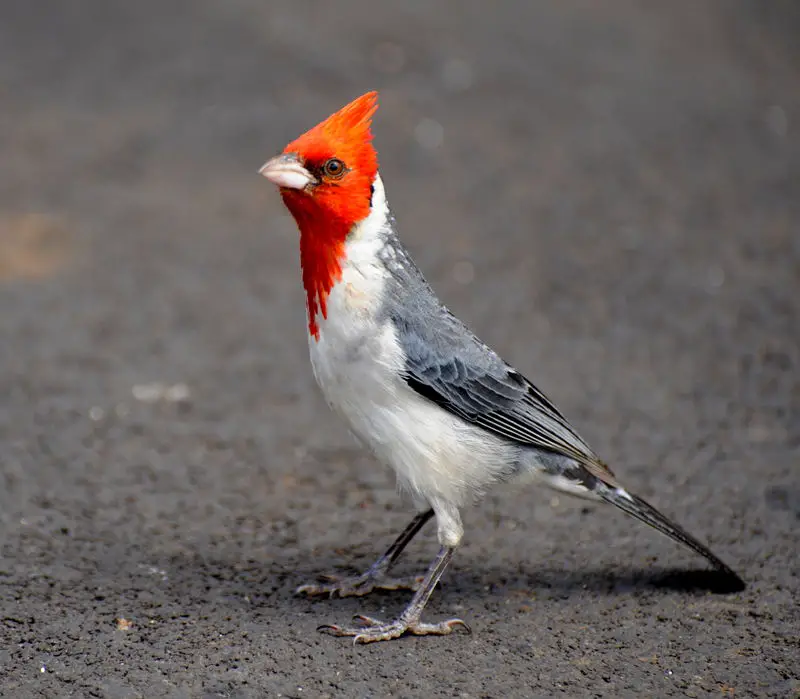
The Red-crested Cardinal is a brightly colored songbird belonging to the family of tanagers. It has a vibrant red crest and its name comes from the Tupí people, which means “small red, yellow, and gray bird”.
This species can be found in most parts of South America where it prefers open woodlands or grassy areas near rivers.
Its diet consists mainly of insects but also includes some fruit when available. The Red-crested Cardinal is well known for its melodious songs that are used by males to attract mates during breeding season.
These birds form monogamous pairs with both parents helping out with raising their young until they learn how to fly on their own within 21 days after hatching from eggs in nest made up high trees or bushes.
In recent years there have been reports about population decline due loss habitat caused by deforestation as well as illegal hunting for pet trade business so conservation efforts are necessary in order to protect this beautiful species from extinction.Scientific classification:
| Kingdom | Animalia |
| Phylum | Chordata |
| Class | Aves |
| Order | Passeriformes |
| Family | Thraupidae |
| Genus | Paroaria |
| Species | P. coronata |
8. Chalk-Browed Mockingbird
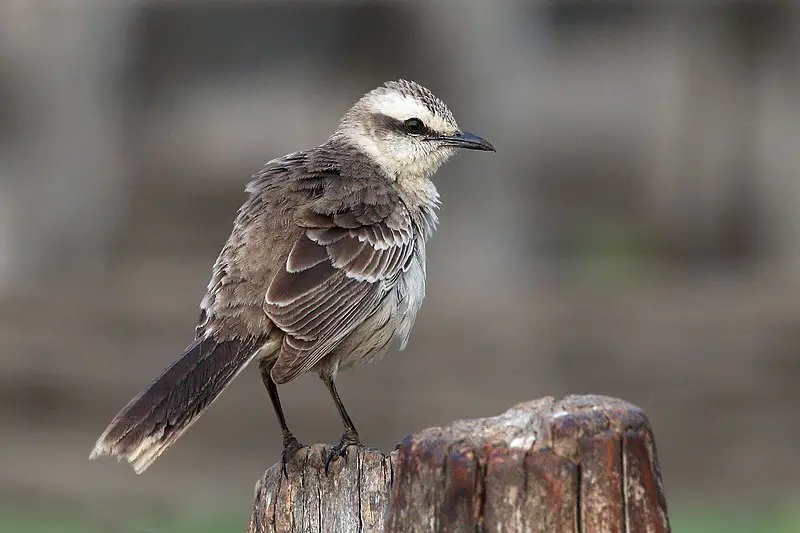
The Chalk-browed mockingbird is a species of bird belonging to the family Mimusidae, found in South America. It has four subspecies and measures between 23.5 and 26 cm long, weighing 55 to 73 g on average.
Its plumage is greyish brown with darker wings, white stripes above the eyes and chestnut underparts that merge into its back feathers creating an ombre effect. They are usually seen alone or in pairs singing their loud melodies throughout open areas such as grasslands or fields with scattered trees.
Their diet consists mainly of insects but also includes fruits from time to time depending on availability which makes them omnivores by nature.
They feed during morning hours followed by active periods of foraging after sunset when temperatures are cooler making it easier for them to find food sources quickly before night falls again along with roosting spots in dense vegetation nearby where they rest until dawn arrives once more.Scientific classification:
| Kingdom | Animalia |
| Phylum | Chordata |
| Class | Aves |
| Order | Passeriformes |
| Family | Mimidae |
| Genus | Mimus |
| Species | M. saturninus |
9. Crested Caracara
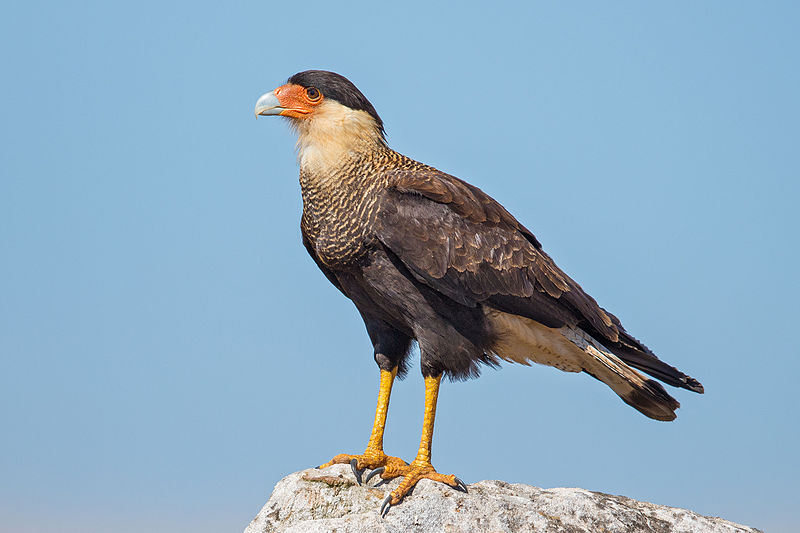
The Crested Caracara is a majestic bird of prey found from the Southern United States through Central and South America, all the way down to Tierra del Fuego.
It has an impressive wingspan ranging from 120-132 cm, with adults averaging 1,348 g in weight. This species is known for its characteristic crest on top of their head that can be raised when they are alarmed or excited.
They have pale yellow legs and feet along with dark brown feathers covering most of their body.
The Crested Caracara feeds mainly on carrion but will also take live food such as small mammals, reptiles and birds as well as garbage if it’s available near them.
These amazing raptors form strong family bonds between siblings which often last until adulthood; making them one of nature’s most remarkable creatures.Scientific classification:
| Kingdom | Animalia |
| Phylum | Chordata |
| Class | Aves |
| Order | Falconiformes |
| Family | Falconidae |
| Genus | Caracara |
| Species | C. plancus |
10. Black Vulture
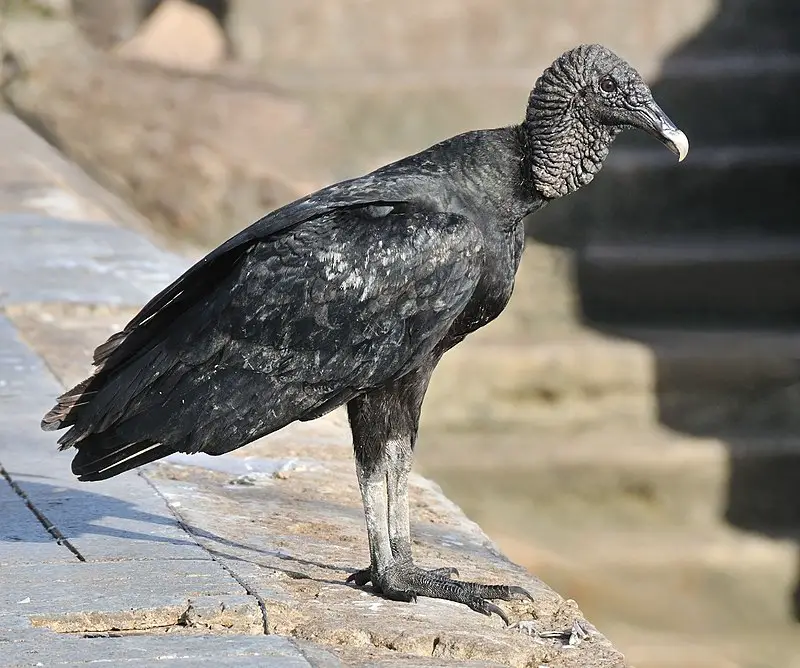
The black vulture is a common and widespread species of New World Vultures, found in the northeastern United States all the way to Peru, Central Chile and Uruguay.
It’s distinctive appearance has earned it many nicknames such as zopilote, urubu or gallinazo.
This medium-sized bird has mainly black plumage with some white markings on its wings and head; also featuring a long bill for scavenging carrion from carcasses.
Despite being able to fly up high due to its broad wingspan, it prefers keeping close to ground level when searching for food items like dead fish or small mammals that are available near human settlements.
As an apex predator they play an important role in nature by helping keep their environment clean while providing other animals with sustenance through their leftovers.Scientific classification:
| Kingdom | Animalia |
| Phylum | Chordata |
| Class | Aves |
| Order | Accipitriformes |
| Family | Cathartidae |
| Genus | Coragyps |
| Species | C. atratus |
11. Neotropic Cormorant
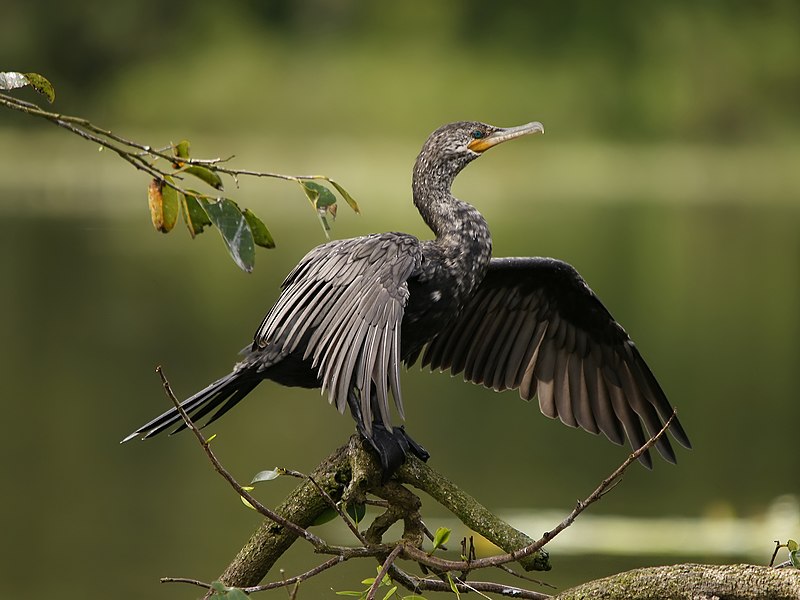
The Neotropic Cormorant, also known as the Olivaceous Cormorant, is a medium-sized bird found in tropical and subtropical regions of Central America, South America and the United States.
It can be identified by its black body with bright yellow facial skin on both sides of its large bill. The tail feathers are short and squared off at the tip.
This species breeds mainly on coasts but will sometimes nest inland near rivers or lakes during certain parts of their life cycle.
They feed mostly on small fish caught while diving underwater but can also eat crustaceans, amphibians and insects.
These birds roost in trees at night to keep safe from predators like foxes which prey upon them when they sleep close to water sources during daylight hours.Scientific classification:
| Kingdom | Animalia |
| Phylum | Chordata |
| Class | Aves |
| Order | Suliformes |
| Family | Phalacrocoracidae |
| Genus | Nannopterum |
| Species | N. brasilianum |
12. Eared Dove
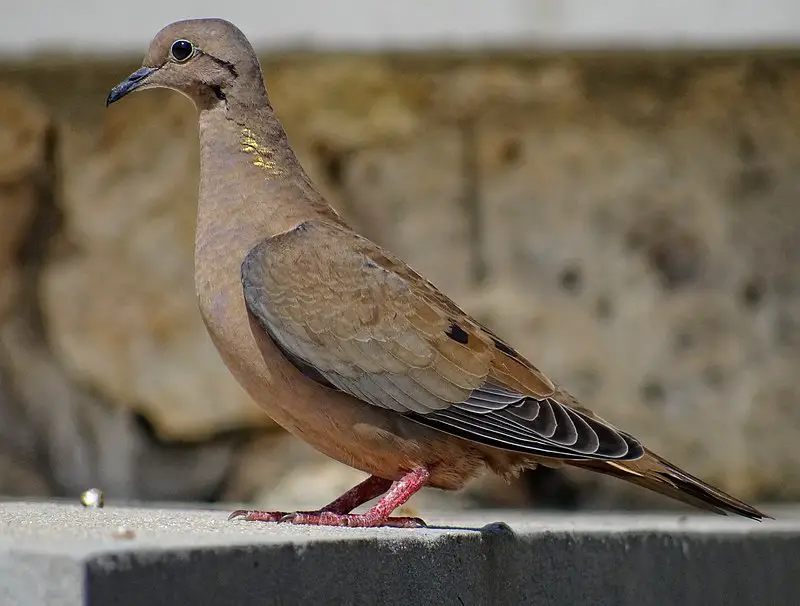
The Eared Dove is a beautiful bird that can be found throughout South America, ranging from Colombia to Argentina and Chile. It has also been spotted in Trinidad and Tobago recently.
This species tends to be partially migratory depending on food supplies available in the area, making it an important part of the local environment.
Its plumage tends to vary by region with some individuals having brighter colors than others where they are found near forested areas or along coasts.
The most recognizable feature of this dove is its ear tufts which gives it its common name – Eared Dove.
These doves have a soft cooing sound as their call which makes them truly unique among other birds in their range.Scientific classification:
| Kingdom | Animalia |
| Phylum | Chordata |
| Class | Aves |
| Order | Columbiformes |
| Family | Columbidae |
| Genus | Zenaida |
| Species | Z. auriculata |
13. Guira Cuckoo
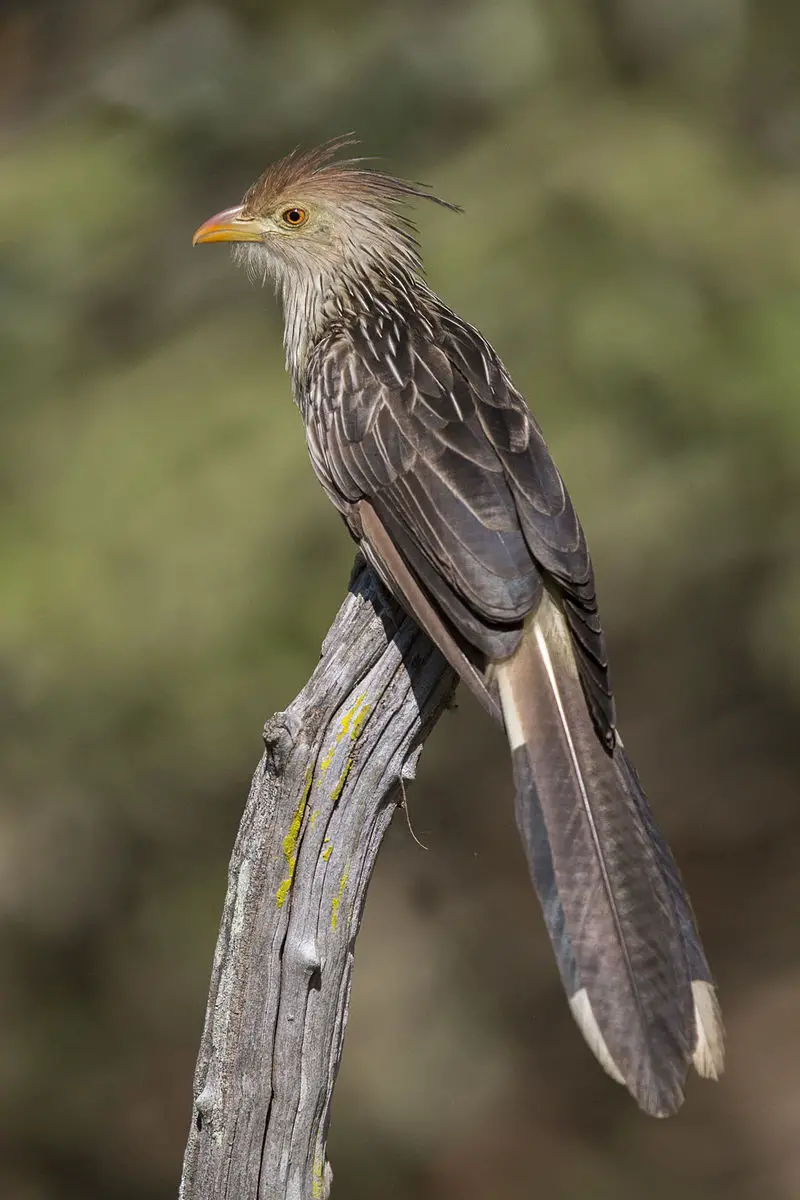
The guira cuckoo is a large, gregarious bird found in open and semi-open habitats of northern South America. It has a distinctive call that can be heard throughout the day, earning it its name due to its resemblance to the sound of a guiro or güiro instrument.
The species was first described by German naturalist Georg Marcgrave in 1648 as part of his Historia Naturalis Brasiliae.
They live mainly on insects but may also take small vertebrates such as frogs or lizards if available. Their nests are built high up in trees with twigs, grasses, leaves and feathers for lining.
These birds are social animals often seen congregating around water sources during hot weather periods when food becomes scarce.Scientific classification:
| Kingdom | Animalia |
| Phylum | Chordata |
| Class | Aves |
| Order | Cuculiformes |
| Family | Cuculidae |
| Genus | Guira Lesson, 1830 |
| Species | G. guira |
14. Plovers

Plovers are a family of around 64-68 species of ground-dwelling birds, commonly found in open country such as fields, meadows and tundras.
They have short bills with webbed feet to help them forage through mud or shallow water.
Plover plumage is usually mottled brown though some species may have brighter colors on the head and wings.
These birds feed mainly on insects but can also eat small crustaceans and worms.
Plovers breed during springtime when they dig holes in sandy or pebbled beaches to lay their eggs which hatch after about 3 weeks incubation period.
They use distraction display behaviour by pretending an injury to the predators away from their nests if needed for protecting their young ones.Scientific classification:
| Kingdom | Animalia |
| Phylum | Chordata |
| Class | Aves |
| Order | Charadriiformes |
| Family | Charadriidae Leach, 1820 |
15. Rosy-Billed Pochard
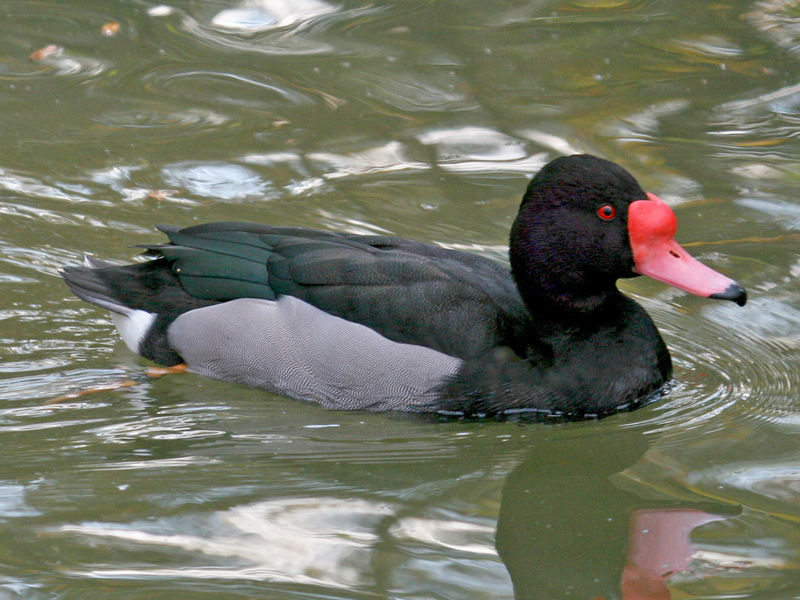
The Rosy-billed Pochard is a beautiful diving duck found in parts of South America. It has an unmistakable bright red bill, hence its name. This species feeds much like dabbling ducks on seeds, roots, aquatic plants and other grasses.
Its scientific name Netta peposaca is derived from Ancient Greek for “duck” and the Guaraní word meaning “showy waterfowl” respectively.
They are usually observed swimming in large flocks with their heads down while they look for food underwater or upending to reach submerged vegetation and invertebrates such as crustaceans and mollusks .
Breeding season begins during late summer but these birds can be seen year round near wetlands such as lakes or slow moving streams where it finds ample sources of food supply along with suitable nesting sites away from predators.Scientific classification:
| Kingdom | Animalia |
| Phylum | Chordata |
| Class | Aves |
| Order | Anseriformes |
| Family | Anatidae |
| Genus | Netta |
| Species | N. peposaca |
16. Black Skimmer
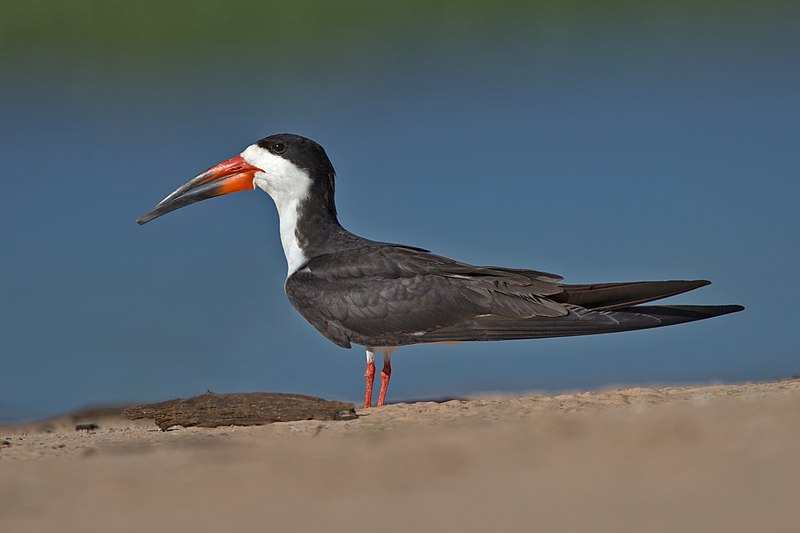
The Black Skimmer is a seabird which belongs to the skimmer genus Rynchops and Laridae family.
It breeds in North and South America, while Northern populations migrate south for winter towards warmer climates such as the Caribbean or Pacific coasts.
The Southern American races have adapted to annual floods by making shorter migrations during this time.
These birds are easily identified with their unique long red bill that has an upper mandible longer than its lower mandible.
They feed mainly on small fish caught at night when they skim across shallow water using their beak like a knife cutting through waves of water.
Their dark grey back contrasts against white belly feathers creating beautiful patterns in flight, aiding them in catching prey easier due to its camoflauge effect above and below waters surface.Scientific classification:
| Kingdom | Animalia |
| Phylum | Chordata |
| Class | Aves |
| Order | Charadriiformes |
| Family | Laridae |
| Genus | Rynchops |
| Species | R. niger |
17. Glittering-Bellied Emerald
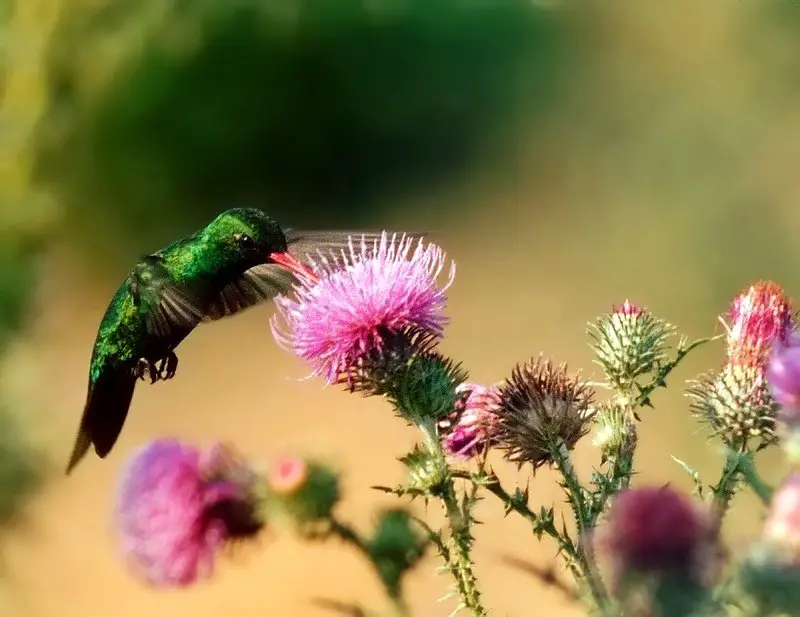
The Glittering-bellied Emerald is a species of hummingbird that can be found in Argentina, Bolivia, Brazil, Paraguay and Uruguay.
It has striking plumage with shimmery green on its back and belly along with speckles of gold.
This beautiful bird was formerly known as Chlorostilbon aureoventris but recent research showed the correct name to be lucidus.
The emerald’s wings beat up to 80 times per second when flying. They feed mainly on nectar from flowers so they are important pollinators for many plants in their habitat range.
These birds also have sharp vision which helps them locate food sources quickly even at long distances.Scientific classification:
| Kingdom | Animalia |
| Phylum | Chordata |
| Class | Aves |
| Order | Apodiformes |
| Family | Trochilidae |
| Genus | Chlorostilbon |
| Species | C. lucidus |
18. Gilded Sapphire
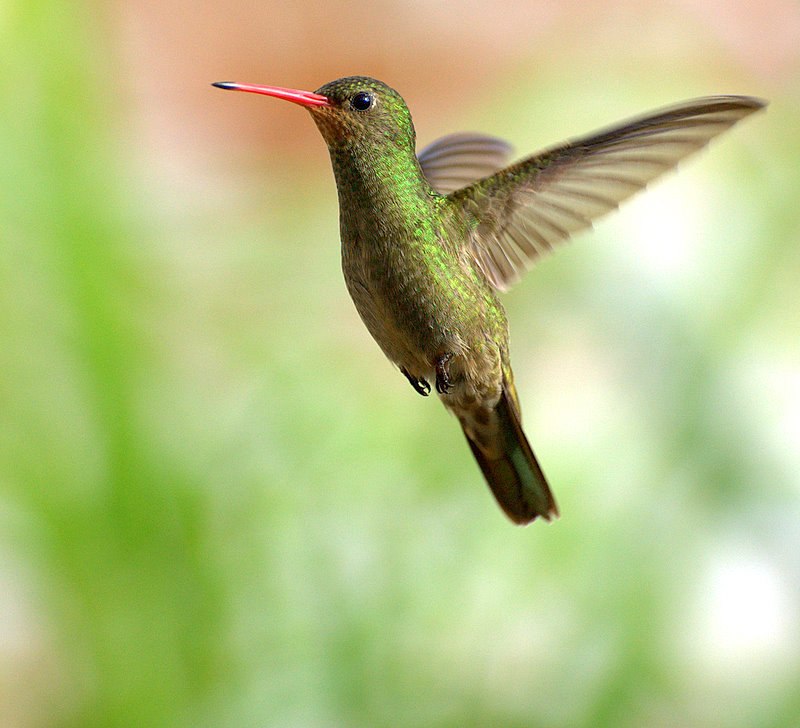
The Gilded Sapphire, also known as the Gilded Hummingbird is a species of hummingbird which can be found in Argentina, Bolivia, Brazil, Paraguay and Uruguay.
It sports an emerald green back with golden-yellow underparts that shine when light catches them at certain angles giving it its name.
The wings are shades of blue while the tail feathers have white tips on each one.
They feed off small insects and nectar from flowers like other hummingbirds do but what makes this bird stand out from others is its remarkable ability to hover over a spot for long periods of time without flapping their wings making it quite mesmerizing to watch.Scientific classification:
| Kingdom | Animalia |
| Phylum | Chordata |
| Class | Aves |
| Order | Apodiformes |
| Family | Trochilidae |
| Genus | Hylocharis |
| Species | H. chrysura |
19. White-Rumped Swallow
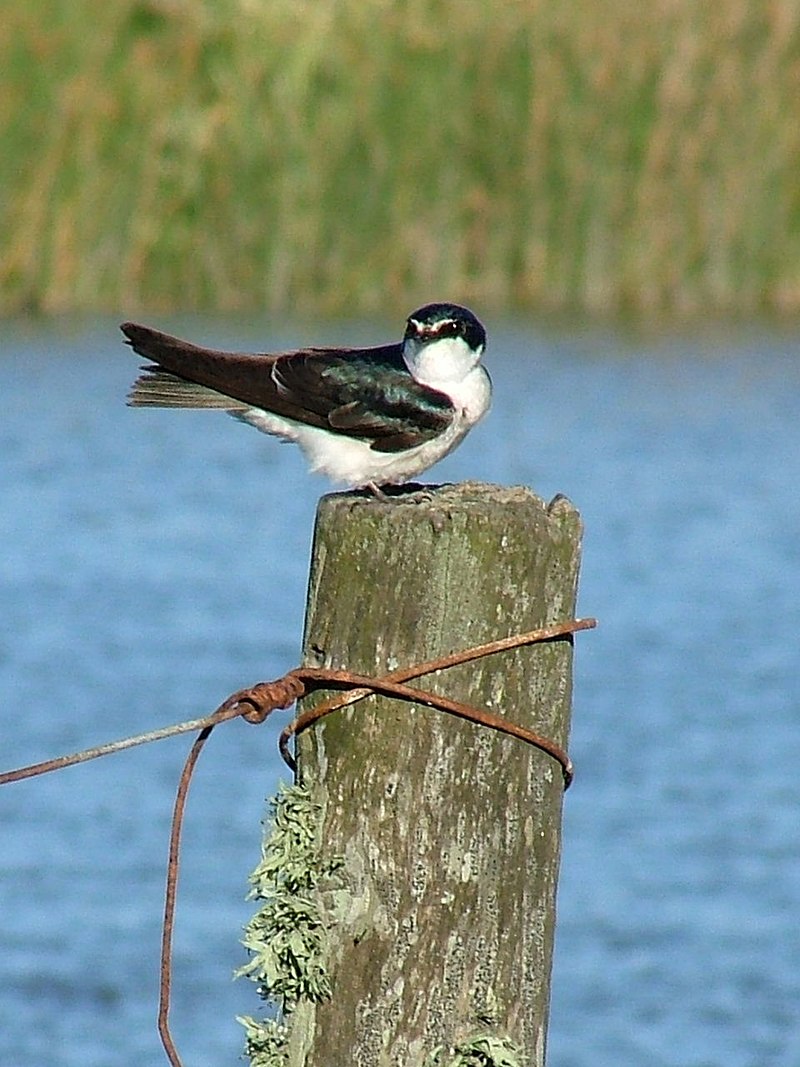
The White-rumped Swallow is a species of bird belonging to the family Hirundinidae. Native to South America, it was first described and given its binomial name by French ornithologist Louis Vieillot in 1817.
It has a distinctive white supraloral streak above its lores (region between eyes and bill). T
he swallow typically migrates from northern Argentina up through Peru, Ecuador and Colombia before settling in Central American countries like Mexico or Guatemala during winter months.
The species is monotypic with no known population variations – making conservation efforts all the more important for this unique bird.Scientific classification:
| Kingdom | Animalia |
| Phylum | Chordata |
| Class | Aves |
| Order | Passeriformes |
| Family | Hirundinidae |
| Genus | Tachycineta |
| Species | T. leucorrhoa |
20. Green-Barred Woodpecker
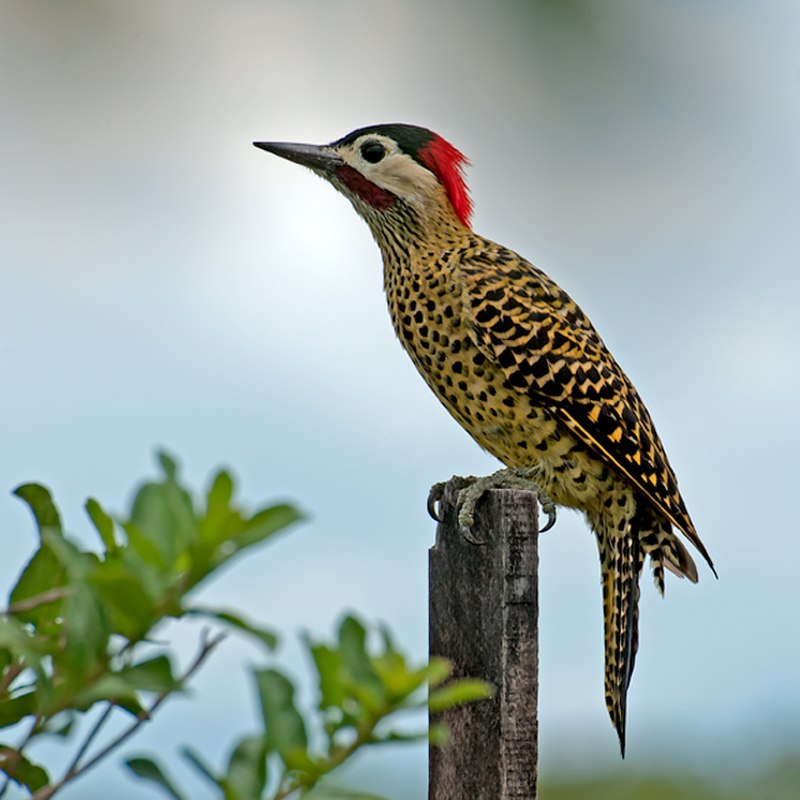
The Green-barred Woodpecker is a beautiful species of bird belonging to the Picidae family. It has striking black and pale green plumage, which gives it its scientific name melanochloros – meaning ‘black’ and ‘pale green’ in Greek.
This woodpecker can be found throughout Central America and Mexico, as well as parts of South America.
The Golden-breasted Woodpecker is sometimes considered part of this same group but may also be viewed as an individual species within the same family.
These birds are known for their strong beaks that they use to chisel through tree bark in search of food such as insects or larvae beneath it.
They have also been observed drilling into rotten logs looking for grubs. As aerial acrobats, these small yet powerful creatures swoop from branch to branch with ease and grace.Scientific classification:
| Kingdom | Animalia |
| Phylum | Chordata |
| Class | Aves |
| Order | Piciformes |
| Family | Picidae |
| Genus | Colaptes |
| Species | C. melanochloros |
21. Ferruginous Pygmy Owl
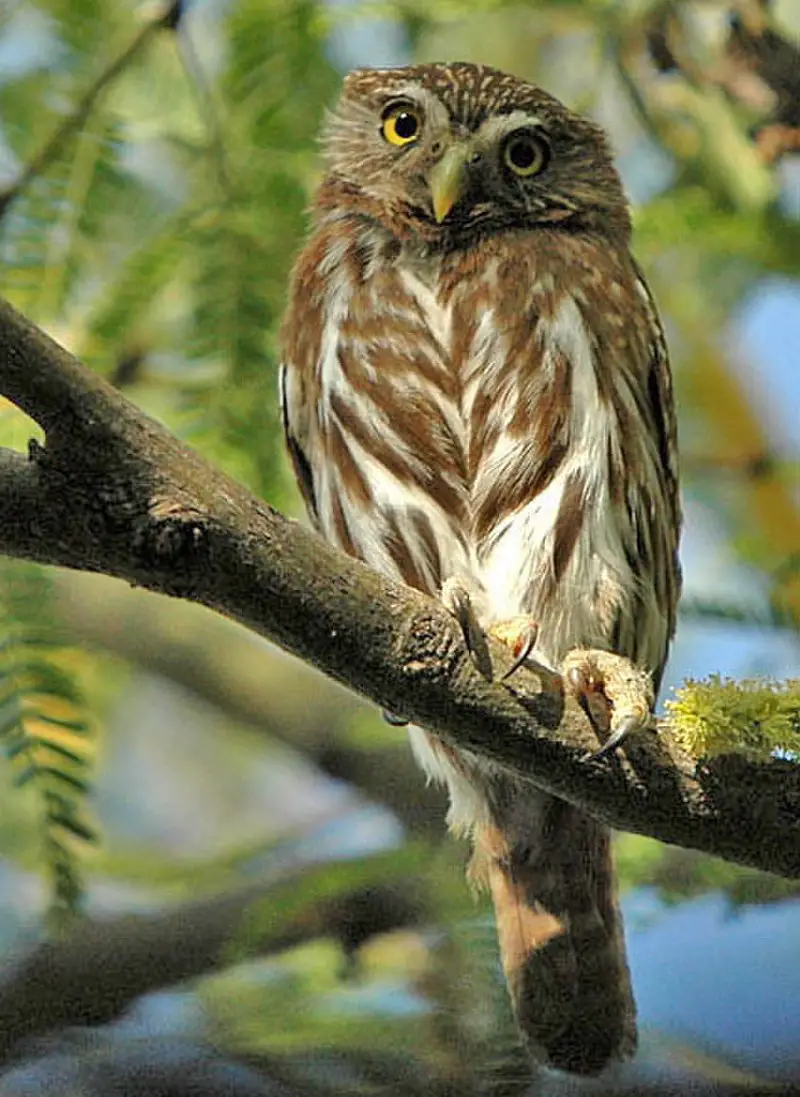
The ferruginous pygmy owl is a small species of owl that can be found throughout much of Central and South America, as well as parts of the United States.
It has rusty-brown feathers on its body, giving it an overall “ferruginous” colouration. The bird feeds mainly on insects and other invertebrates, but also eats some larger prey such as lizards or mice when available.
During breeding season the birds build nests in tree cavities to raise their young. They are usually nocturnal creatures but may become active during daylight hours if disturbed by humans or predators nearby.
This adaptable little raptor is often seen perching atop buildings or street lights in urban areas where they have adapted to live alongside human activity while still finding food sources within cities and townships alike.Scientific classification:
| Kingdom | Animalia |
| Phylum | Chordata |
| Class | Aves |
| Order | Strigiformes |
| Family | Strigidae |
| Genus | Glaucidium |
| Species | G. brasilianum |
Also Featured In: Birds that Live in the Deserts, Birds You’ll Find in South Texas
22. Dusky-Legged Guan
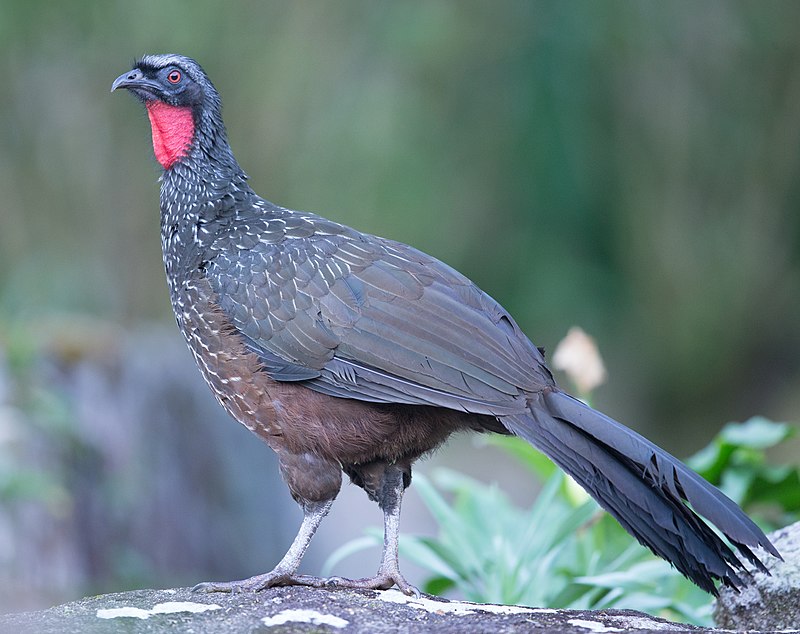
The Dusky-legged Guan is a species of bird found in parts of Uruguay, Argentina, Paraguay and Brazil. It typically inhabits dry forests, shrublands and grasslands near rivers or wetlands.
In 2021 the Yungas guan was recognized as a separate species from its former subspecies P. o bridgesi that is native to southwestern Bolivia and northwestern Argentina.
These birds have mainly dark plumage with some light barring on their underparts while displaying white patches around the eyes when they are alert or active during flight.
They feed primarily on fruits and seeds but can also eat insects such as caterpillars for protein supplements during breeding season when energy demands are higher than usual.
With proper protection these birds could thrive in their natural habitats once again.Scientific classification:
| Kingdom | Animalia |
| Phylum | Chordata |
| Class | Aves |
| Order | Galliformes |
| Family | Cracidae |
| Genus | Penelope |
| Species | P. obscura |
23. South American Tern
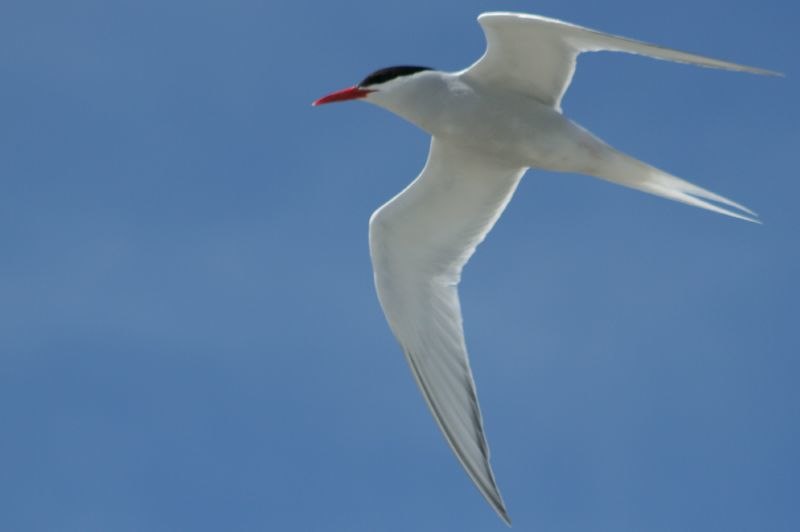
The South American tern is a species of seabird found in coastal regions stretching from the Falklands to Peru and Brazil.
True to its name, this bird has a swallow-like forked tail that helps it soar through the sky with ease.
It also has an impressive wingspan, making it quite easy to spot when flying overhead.
The most distinguishing characteristic of these birds is their bright yellow beak and feet which contrast against their white head and grey body plumage.
They are considered one of the most common terns in their range due to their adaptability across different habitats such as mudflats and beaches or even grassy areas near riversides or lakeshores.
While they usually reside close enough inland so as not to come into contact with humans directly, they can often be seen soaring high above our heads on sunny days.Scientific classification:
| Kingdom | Animalia |
| Phylum | Chordata |
| Class | Aves |
| Order | Charadriiformes |
| Family | Laridae |
| Genus | Sterna |
| Species | S. hirundinacea |
Also Featured In: Common Birds that Live around Ushuaia, Falkland Islands Birds You Need To Know
24. Pantanal Snipe
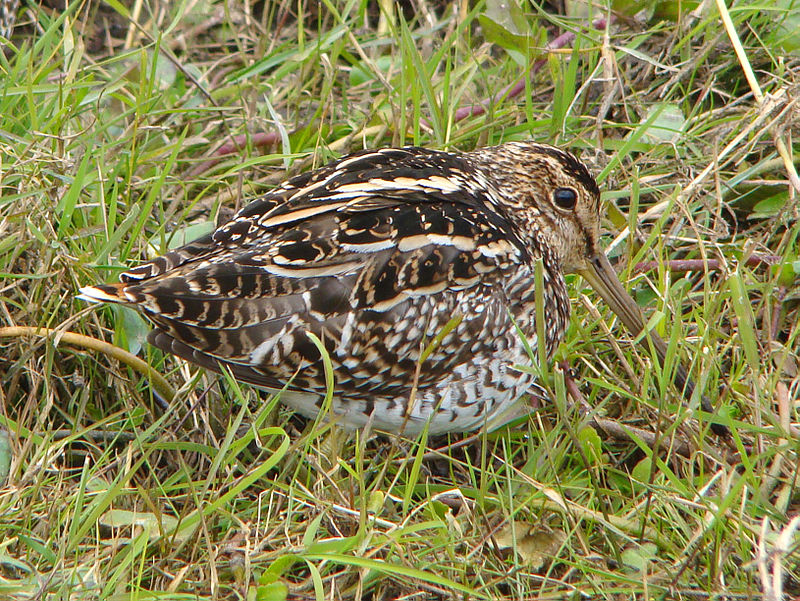
The Pantanal snipe is a member of the sandpiper family and it can be found on Trinidad and Tobago, the Falkland Islands, as well as most mainland countries in South America except Chile.
It has an interesting taxonomic history due to its close relationship with other New World Snipes such as genus Gallinago.
This wading bird typically lives near wetlands or agricultural fields where they feed off small crustaceans like worms and insects.
They are very shy birds that usually fly out of reach when disturbed by humans or predators.
Their coloring helps them blend into their environment which makes them difficult to spot while they search for food during low tide periods.
The Pantanal snipe is a vital part of many ecosystems throughout South America, so conservation efforts must continue to ensure this species remains healthy for future generations.Scientific classification:
| Kingdom | Animalia |
| Phylum | Chordata |
| Class | Aves |
| Order | Charadriiformes |
| Family | Scolopacidae |
| Genus | Gallinago |
| Species | G. paraguaiae |
25. Yellow Cardinal
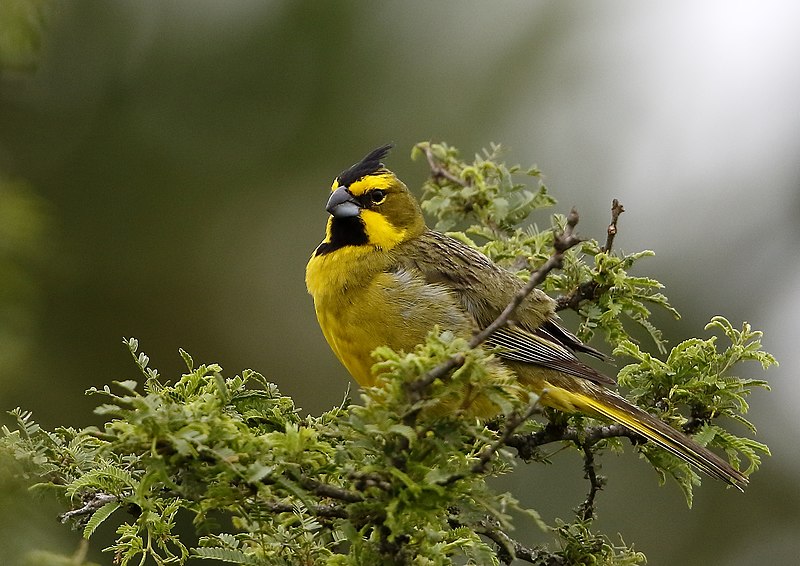
The Yellow Cardinal is a species of bird found in South America, and is the only member of its genus. It has bright yellow plumage and black wings with white tips – giving it an unmistakable appearance.
Its habitat includes open woodlands and grassland areas, where it feeds on seeds from native plants as well as fruits such as bananas.
The population size for this species is small due to hunting pressure, but conservation efforts are beginning to help increase numbers.
This rare beauty was first described by French ornithologist Louis Jean Pierre Vieillot in 1817 under the binomial name Coccothraustes cristata; since then they have captivated people’s hearts all over the world.Scientific classification:
| Kingdom | Animalia |
| Phylum | Chordata |
| Class | Aves |
| Order | Passeriformes |
| Family | Thraupidae |
| Genus | Gubernatrix Lesson, 1837 |
| Species | G. cristata |
Also Featured In: Patagonia Birds You Should Know,
26. Southern Screamer
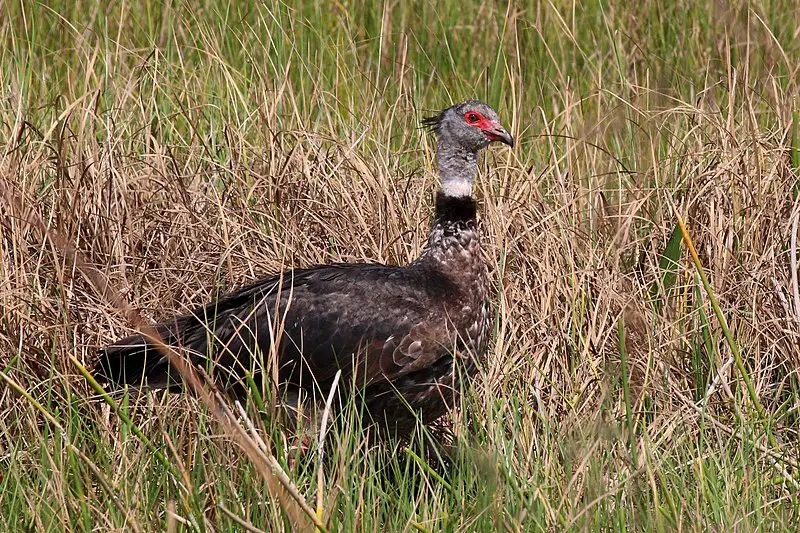
The Southern screamer is a species of bird found in South America, belonging to the family Anhimidae. It has an unmistakable call that sounds like “screaming”, earning it its name.
The plumage is primarily white and black with bright yellow eyes, legs and bill. They are large birds measuring up to 75 centimeters long from beak to tail-tip.
These birds inhabit wetlands such as swamps and marshes where they feed on seeds, grains, aquatic plants and small invertebrates which they find while wading or diving into shallow water bodies.
Despite their loud calls when alarmed or disturbed these birds have adapted well to human presence by living around agricultural areas near humans settlements where food sources are plentiful making them quite common within their range..Scientific classification:
| Kingdom | Animalia |
| Phylum | Chordata |
| Class | Aves |
| Order | Anseriformes |
| Family | Anhimidae |
| Genus | Chauna |
| Species | C. torquata |
27. Seriema
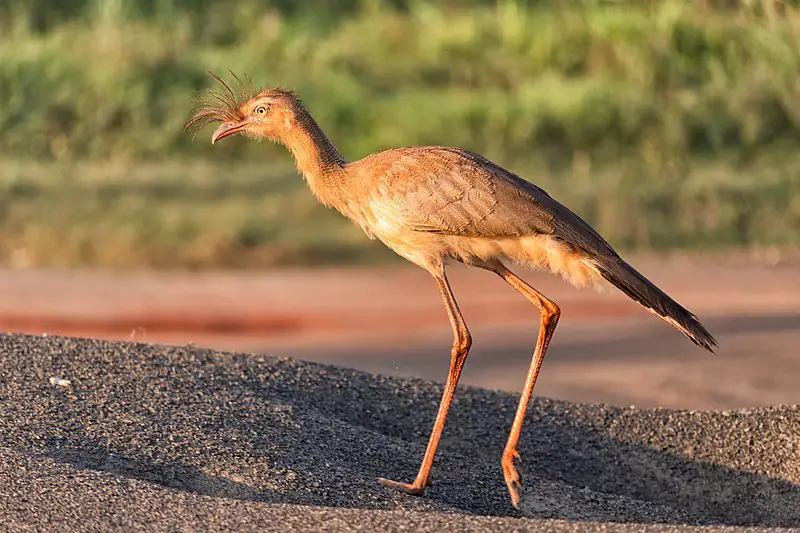
Seriemas are the only living birds of their family, Cariamidae.
They were once thought to be related to cranes but now they have been placed alongside falcons, parrots and passerines in a unique order known as Cariamiformes.
These birds measure up to 90 cm (35 inches) tall with long legs that make them look quite impressive.
Seriemas live in large territories where they hunt for insects and small animals such as rodents or lizards. They also feed on fruits, seeds and flowers found within their range.
As territorial birds, seriemas are very protective of their habitats – even going so far as chasing away larger predators like foxes or coyotes when necessary.
Overall these strange-looking creatures provide an interesting addition to any aviary looking for something new and unusual.Scientific classification:
| Kingdom | Animalia |
| Phylum | Chordata |
| Class | Aves |
| Order | Cariamiformes |
| Superfamily | Cariamoidea Bonaparte, 1853 |
| Family | Cariamidae Bonaparte, 1853 |
28. Skuas
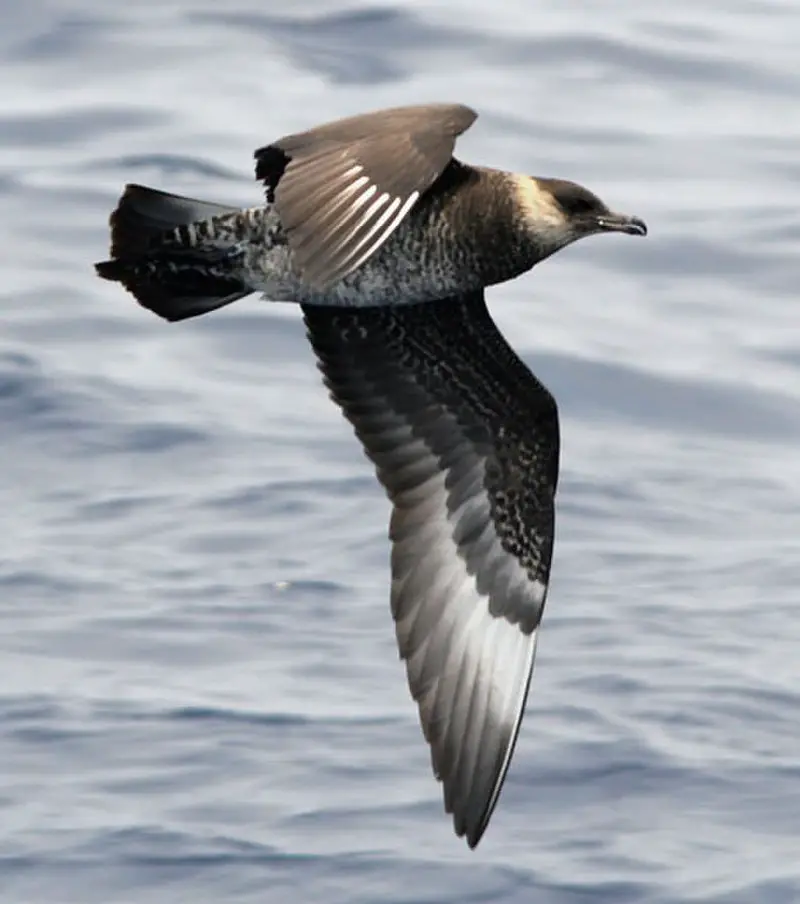
Skuas are a group of predatory seabirds with seven species, all belonging to the genus Stercorarius.
They are also known as “Jaegers” in North America and their name originates from the Faroese word for Great Skua – skúgvur.
These birds typically inhabit coastal areas or open oceans where they feed on fish, krill and other marine creatures.
Skuas can be distinguished by their pointed wings which help them fly long distances while hunting food.
Their distinctive colouration varies depending on age and habitat but generally includes greyish brown upperparts and white underparts with black streaks along its belly area.
The overall size ranges from 24-40 cm making these one of the larger sea bird species.Scientific classification:
| Kingdom | Animalia |
| Phylum | Chordata |
| Class | Aves |
| Order | Charadriiformes |
| Suborder | Lari |
| Family | Stercorariidae Gray, 1871 |
| Genus | Stercorarius Brisson, 1760 |
29. Turkey Vulture
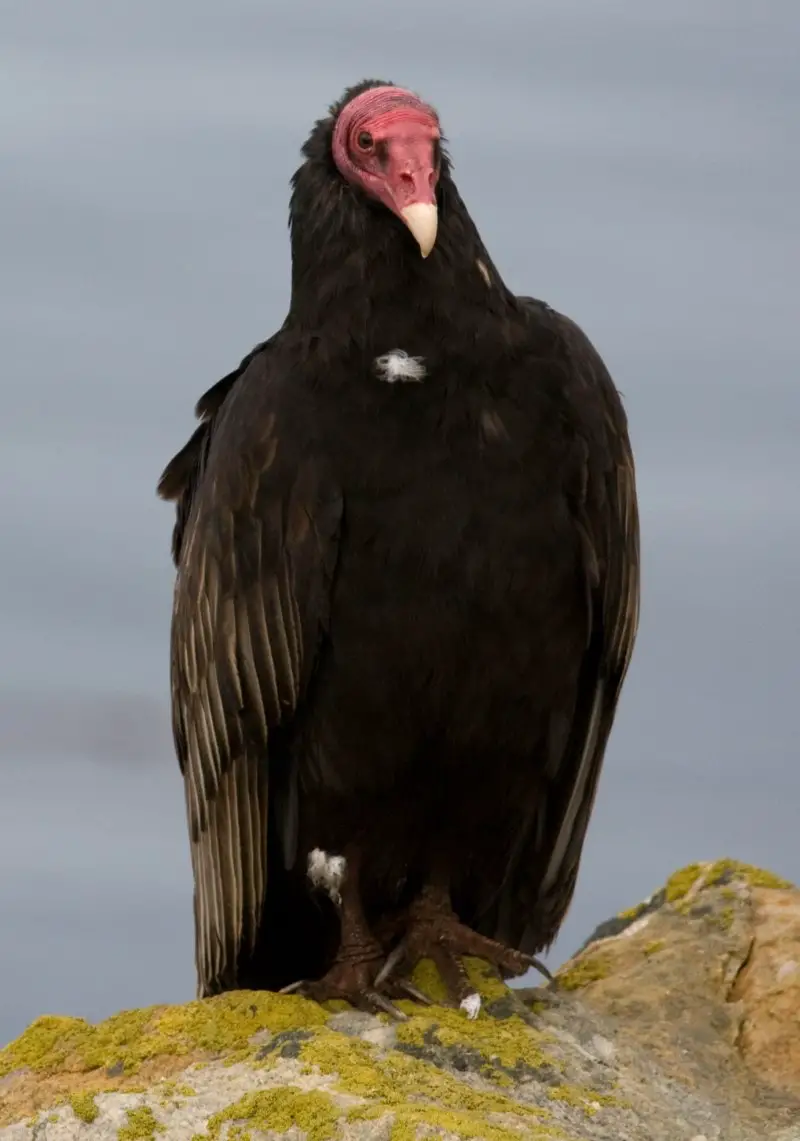
The turkey vulture is a large bird of prey that can be found in many parts of the world. It has a wingspan of up to 6 feet and its feathers are mostly black with brownish-red patches on the underside which give it an overall dark red appearance.
Its head is bald, which helps protect it from getting overheated when flying long distances looking for food.
The Turkey Vulture usually feeds off carrion but will also feed on fruit and insects.
Its keen eyesight allows them to spot potential meals from miles away while they soar through the sky using their broad wings and thermal air currents to stay aloft without expending much energy.
They are very important scavengers as they keep ecosystems healthy by consuming dead animals before disease can spread amongst living creatures or contaminate local water sources like rivers or lakesScientific classification:
| Kingdom | Animalia |
| Phylum | Chordata |
| Class | Aves |
| Order | Accipitriformes |
| Family | Cathartidae |
| Genus | Cathartes |
| Species | C. aura |
30. Shiny Cowbird
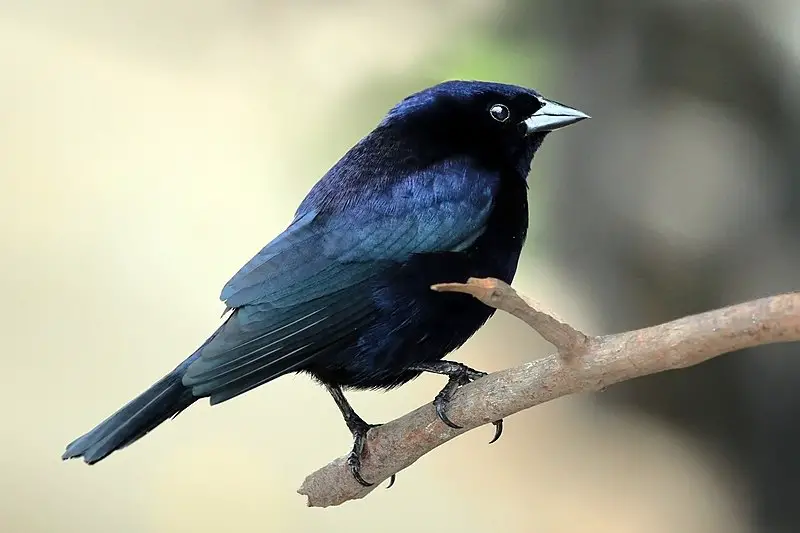
The Shiny Cowbird is a passerine bird in the New World family Icteridae that breeds mainly throughout South America. Since 1900, its range has expanded northward and it can now be found breeding in southern Florida as well as several Caribbean islands.
The birds are small to medium-sized with glossy black heads and upperparts with white throat patches, brown wings and tails, rust colored underparts, pale yellow eyes, and legs of pinkish orange coloration.
They feed on insects such as grasshoppers in fields or meadows but also take advantage of cultivated fruits when available.
When not nesting they form large flocks which make them easy to spot around their habitats where they search for food together before returning to roost at nightfall.Scientific classification:
| Kingdom | Animalia |
| Phylum | Chordata |
| Class | Aves |
| Order | Passeriformes |
| Family | Icteridae |
| Genus | Molothrus |
| Species | M. bonariensis |
Also Featured In: Common Blue Birds of Georgia,
31. Chilean Flamingo
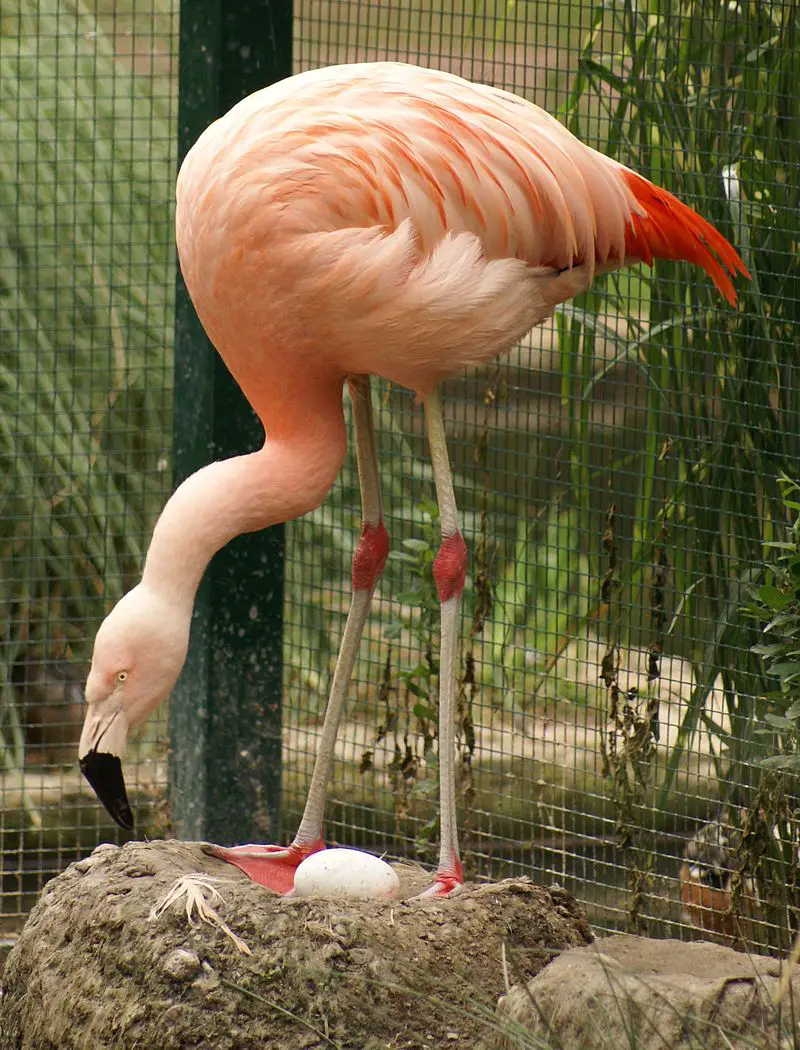
The Chilean Flamingo is a large bird native to South America, ranging from Ecuador and Peru to Chile and Argentina. It is an impressive species of flamingo which stands at 43-51 inches tall.
With its distinctive long neck, bright pink feathers, and black tipped wings – it truly is a sight to behold.
Unfortunately the population of this majestic creature has been decreasing over time due to human activities such as hunting for their meat or eggs.
The IUCN currently lists them as near threatened – meaning we need to act now if we want future generations get the chance experience these beautiful birds in person.
We must be more responsible with our actions so that these iconic animals can live peacefully without fear of harm from humansScientific classification:
| Kingdom | Animalia |
| Phylum | Chordata |
| Class | Aves |
| Order | Phoenicopteriformes |
| Family | Phoenicopteridae |
| Genus | Phoenicopterus |
| Species | P. chilensis |
32. Black-Necked Swan
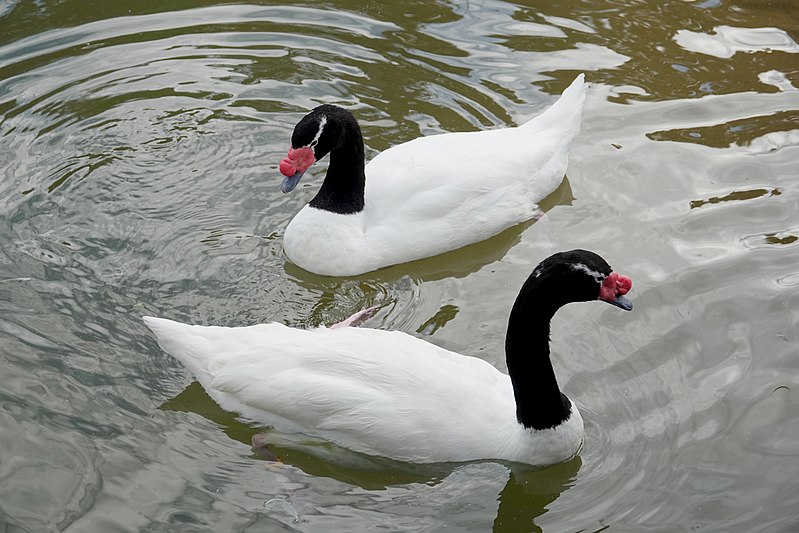
The Black-necked Swan is a species of waterfowl belonging to the Cygnini tribe in subfamily Anserinae. They are native to Argentina, Brazil, Chile, Uruguay and the Falkland Islands.
The black-necked swan has been known to stand out from other members of its family due to its unique appearance; it has an all white body with a black neck and head.
This bird typically lives near freshwater bodies such as lakes or rivers but can also be found on ocean coasts during some seasons when food sources become scarce.
It mainly feeds on algae and aquatic plants though occasionally eats small fish too for extra nutrition.
Overall this gorgeous bird stands proud amongst many others because of their stunning colour combination which makes them unmistakable.Scientific classification:
| Kingdom | Animalia |
| Phylum | Chordata |
| Class | Aves |
| Order | Anseriformes |
| Family | Anatidae |
| Genus | Cygnus |
| Species | C. melancoryphus |
33. Giant Wood Rail
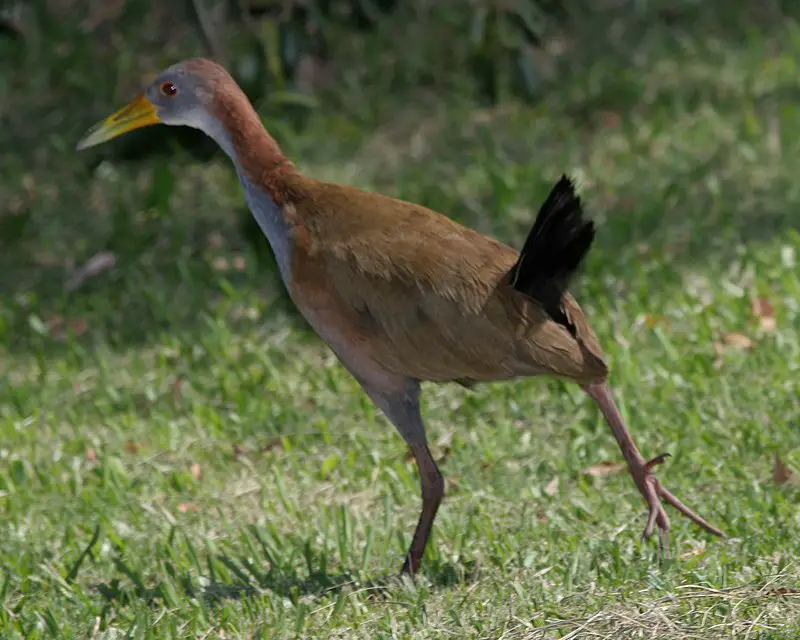
The Giant Wood Rail is a species of bird that belongs to the Rallinae subfamily in the rail, crake and coot family. It inhabits Argentina, Bolivia, Brazil, Paraguay and Uruguay.
Its length ranges from 41-45 cm (16-18 inches). Females can weigh up to 765 g (27 oz) while males are usually much lighter – around 640 g (23 oz).
They have a striking blackish plumage on their head with white stripes running down onto their back.
Their wings also show white edges which contrast against its dark feathers beautifully. The bill is long and yellowish or olive green making it quite distinctive among other birds of its kind.
This amazing creature helps maintain balance in nature through seed dispersal as they feed mostly on grains during rainy season when food resources become abundant for them.Scientific classification:
| Kingdom | Animalia |
| Phylum | Chordata |
| Class | Aves |
| Order | Gruiformes |
| Family | Rallidae |
| Genus | Aramides |
| Species | A. ypecaha |
34. Narrow-Billed Woodcreeper
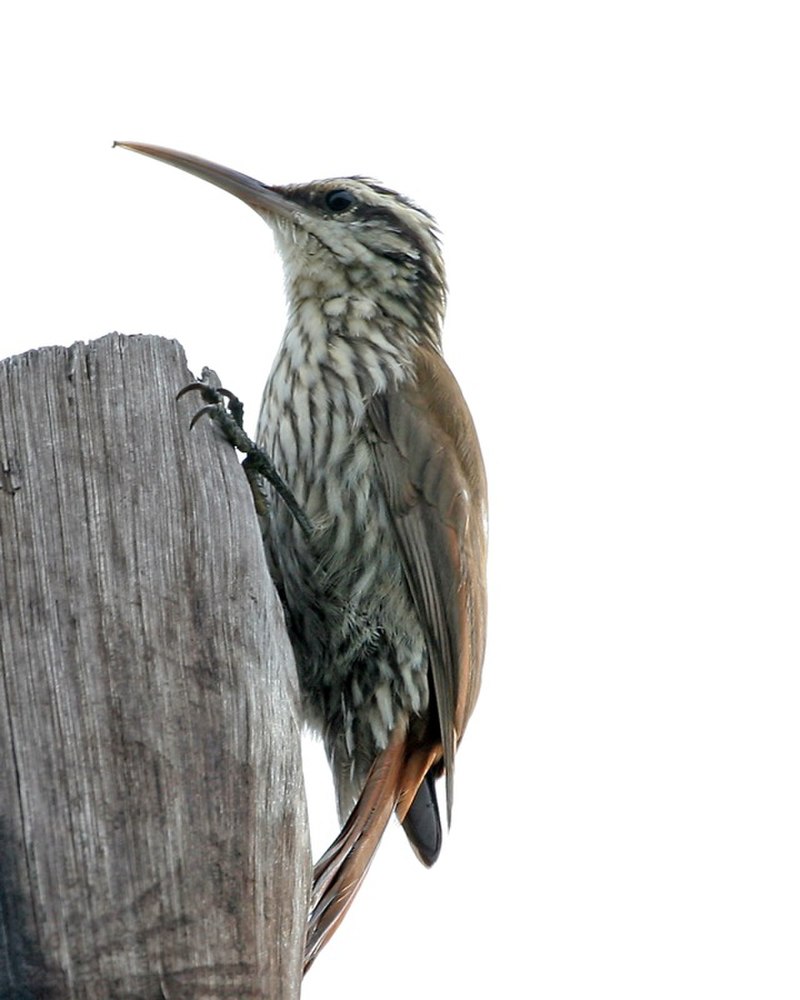
The Narrow-billed Woodcreeper is a species of bird in the Dendrocolaptinae subfamily found throughout much of South America. This small, woodland creature has an elongated bill and lives in subtropical or tropical dry forests and savannas.
It feeds on small arthropods, such as ants and beetles, along with vertebrates like lizards which it catches by creeping under bark or crevices to hunt its prey.
The woodcreepers plumage is generally greyish brown above with dark barring on its wings while underneath tends to be lighter coloured buffy white but may vary depending on location.
Despite being listed as least concern due to having wide range distribution these birds are still vulnerable from destruction caused by deforestation so conservation efforts should continue to protect them moving forward .Scientific classification:
| Kingdom | Animalia |
| Phylum | Chordata |
| Class | Aves |
| Order | Passeriformes |
| Family | Furnariidae |
| Genus | Lepidocolaptes |
| Species | L. angustirostris |
35. Olrog’s Gull
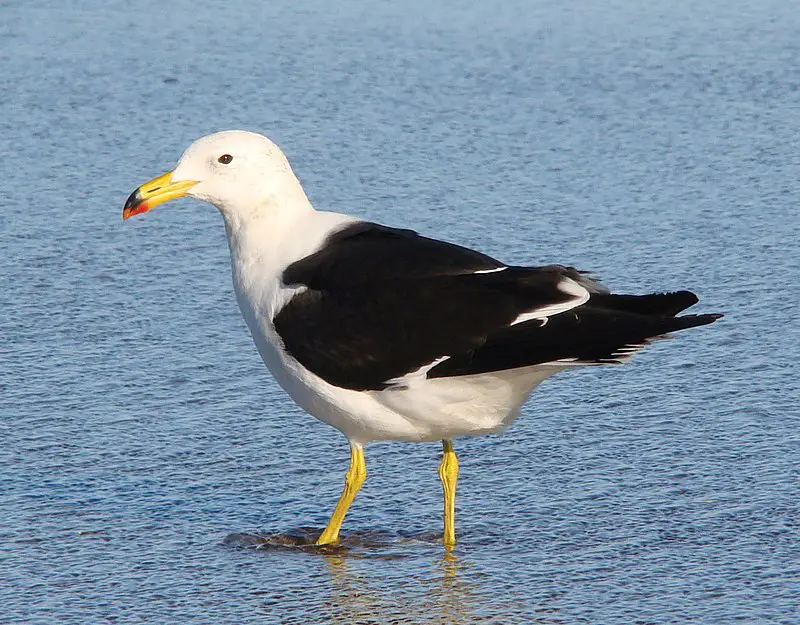
Olrog’s gull is a large species of seagull found along the Atlantic coastlines of southern Brazil, Uruguay and northern Argentina. It has distinctive black wings and back with white head and underparts.
The tail is predominantly white but has a thin black band running through it, while their beak is yellow in colour with red and black markings on its tip.
In non-breeding adults these dark colours tend to become duller as lighter browns take over much of the body plumage.
They are an opportunistic feeder that will eat almost anything they can find such as fish, worms or crustaceans from shallow coastal waters or scraps left behind by humans at marinas or beaches.
Olrog’s gulls are sociable birds that often form large groups when foraging for food together; however during breeding season pairs come together until chicks have fledged after which time they rejoin larger flocks againScientific classification:
| Kingdom | Animalia |
| Phylum | Chordata |
| Class | Aves |
| Order | Charadriiformes |
| Family | Laridae |
| Genus | Larus |
| Species | L. atlanticus |
36. Grey Monjita
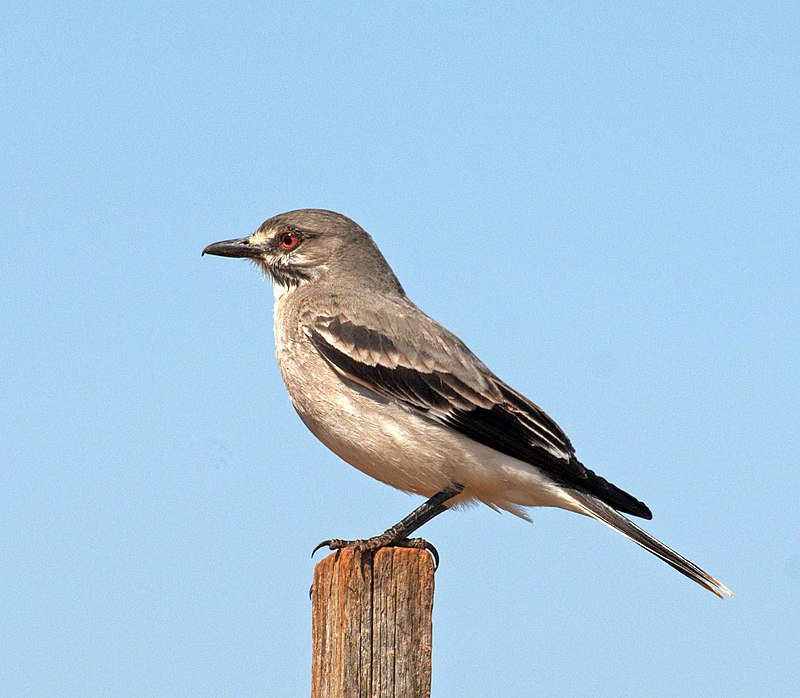
The Grey Monjita is a small bird species of the Tyrannidae family that can be found across South America. It lives in dry savanna, subtropical grasslands and pastures.
They have distinctive grey feathers with a brown tail and black wings tipped white, as well as yellow legs and feet.
Its diet consists mainly of insects such as beetles, moths and mantises which it catches from mid-air or by chasing them on ground level.
This species was formerly placed in the genus Xolmis but has since been moved to its own genus – Nengetus cinereus – due to differences between it’s plumage coloring compared to other members of this group.
The Grey Monjita is an important member of its local environment, providing insect control services for farmers while also bringing beauty into their surroundings.Scientific classification:
| Kingdom | Animalia |
| Phylum | Chordata |
| Class | Aves |
| Order | Passeriformes |
| Family | Tyrannidae |
| Genus | Nengetus Swainson, 1827 |
| Species | N. cinereus |
37. Black-And-White Monjita
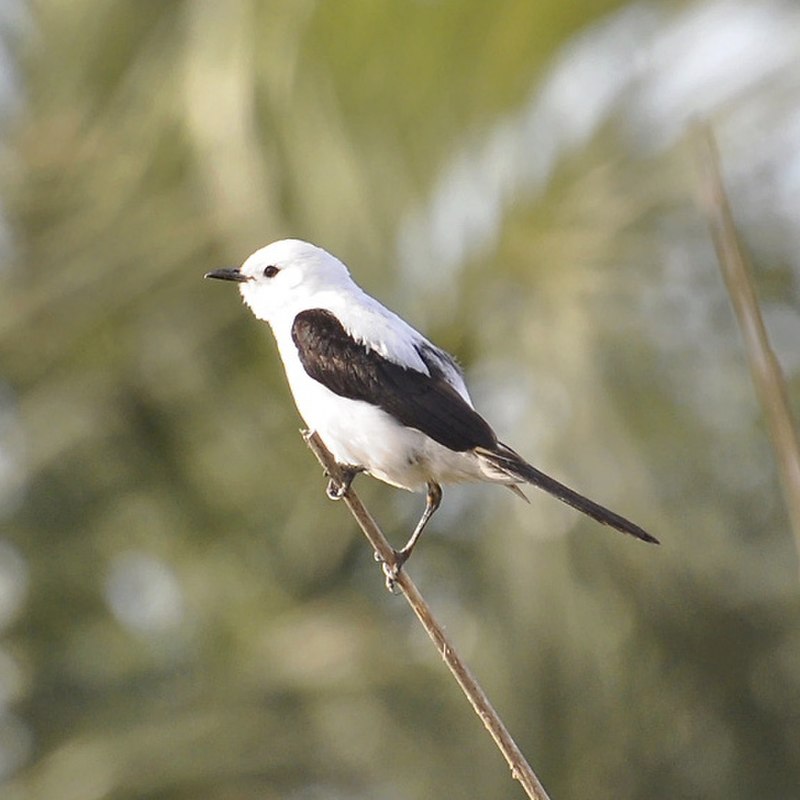
The Black-and-white Monjita is a small passerine bird found in Argentina, Brazil, Uruguay and possibly Paraguay. It has greyish black upperparts with white underparts.
The head is dark brown with chestnut wings and tail feathers. This species prefers dry lowland grasslands, seasonally wet or flooded lowland grasslands and arable land as its natural habitat.
These birds are usually seen perched atop branches looking for food such as insects or seeds from plants. They have also been known to eat fruit when available in the wild.
Their calls consist of sharp chirps that can be heard over long distances due to their loudness and clarity making them easily recognisable even at night time.
Overall this species makes an interesting addition to any backyard zoo – so why not consider adopting one today?Scientific classification:
| Kingdom | Animalia |
| Phylum | Chordata |
| Class | Aves |
| Order | Passeriformes |
| Family | Tyrannidae |
| Genus | Heteroxolmis Lanyon, W, 1986 |
| Species | H. dominicanus |
38. Burrowing Owl
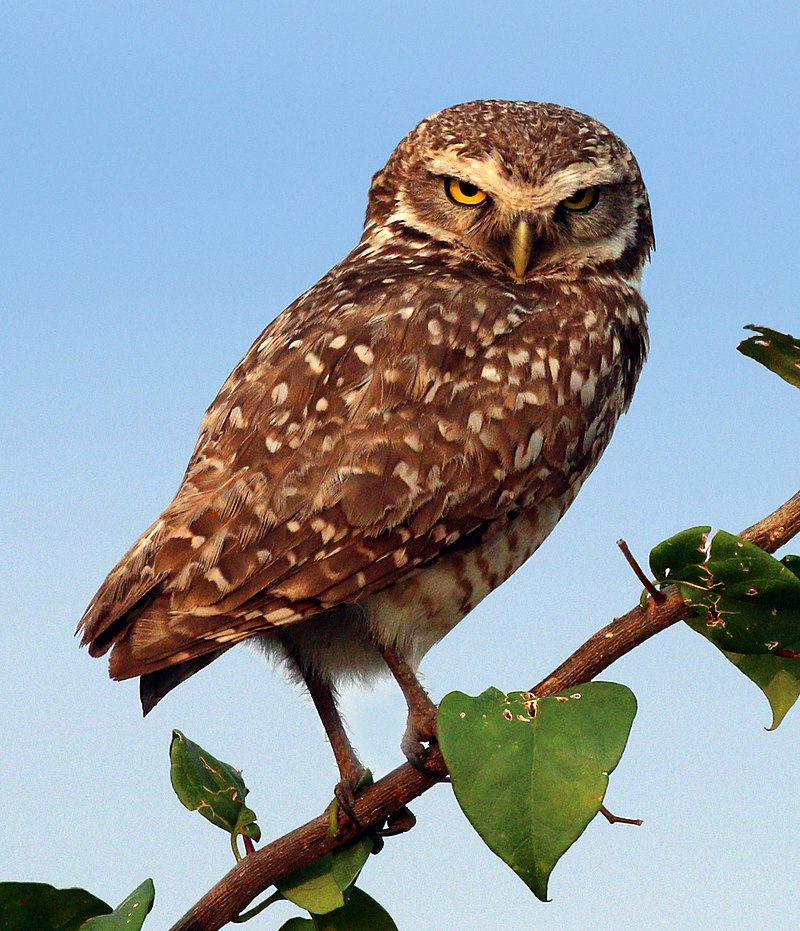
The Burrowing Owl is a small, long-legged owl found in open landscapes throughout North and South America. They are typically seen in grasslands, rangelands, agricultural areas or deserts with low vegetation.
Unlike most owls they nest and roost underground by taking over burrows made by other animals such as prairie dogs.
Their diet consists of insects, rodents and sometimes lizards or frogs that they hunt during the night time hours when their eyesight is sharpest.
This species faces threats due to habitat loss caused by human development but conservation efforts have been successful at reversing some of this damage allowing for populations to remain stable into the future despite these pressures.Scientific classification:
| Kingdom | Animalia |
| Phylum | Chordata |
| Class | Aves |
| Order | Strigiformes |
| Family | Strigidae |
| Genus | Athene |
| Species | A. cunicularia |
39. Plush-Crested Jay
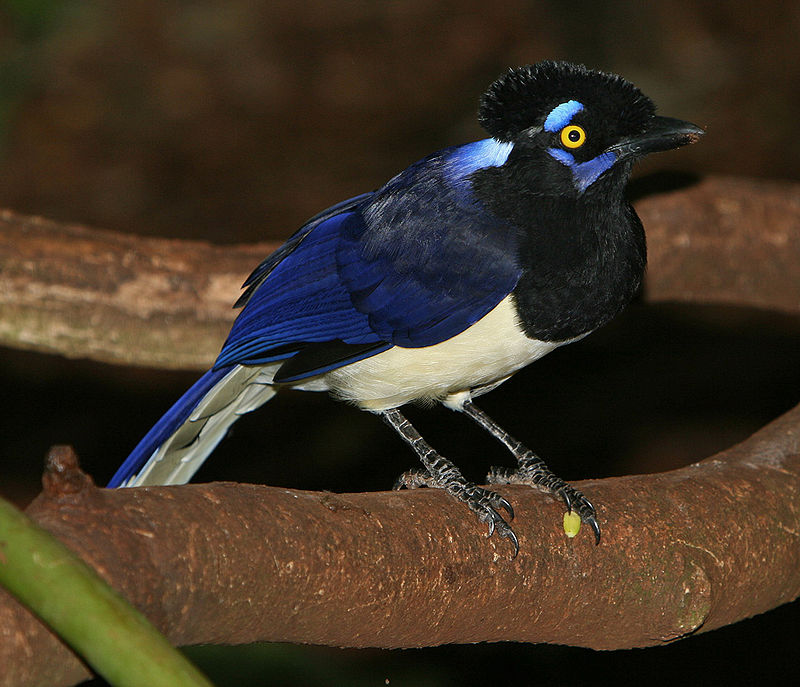
The Plush-crested Jay is a stunning bird found in the central and southern parts of South America. It has dark plumage, with an impressive crest on its head that gives it a regal appearance.
Measuring around 25 cm long, this medium sized bird resides in Brazil, Bolivia, Paraguay, Uruguay and Argentina – particularly near the Amazon Basin river systems bordering the Pantanal.
Its diet consists mostly of insects such as grasshoppers or beetles but also includes small fruits like berries and nuts which they find while foraging through trees and bushes.
They are known to be quite vocal birds often calling out loudly during mating season to attract potential mates – their calls being described as harsh crows mixed with chattering noises.Scientific classification:
| Kingdom | Animalia |
| Phylum | Chordata |
| Class | Aves |
| Order | Passeriformes |
| Family | Corvidae |
| Genus | Cyanocorax |
| Species | C. chrysops |
40. Fork-Tailed Flycatcher
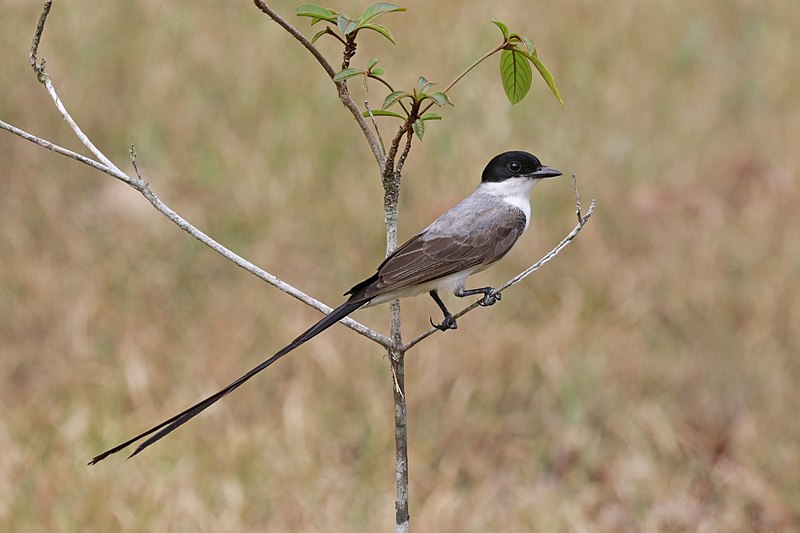
The Fork-tailed Flycatcher is a strikingly beautiful bird belonging to the tyrant flycatcher family. It has an unmistakable long and forked tail, which gives it its name.
This species can be found from southern Mexico all the way down to Argentina in lightly forested or grassland areas.
They are usually seen perched atop trees or other tall structures, surveying their surroundings with keen eyesight.
Though they may look intimidating due to their size, these birds feed on small insects like flies and beetles; making them beneficial predators that help keep insect populations under control.
Despite being widespread throughout much of South America, sadly this species is considered near threatened due to deforestation occurring in many of its habitats across range countries.Scientific classification:
| Kingdom | Animalia |
| Phylum | Chordata |
| Class | Aves |
| Order | Passeriformes |
| Family | Tyrannidae |
| Genus | Tyrannus |
| Species | T. savana |
41. Buff-Necked Ibis
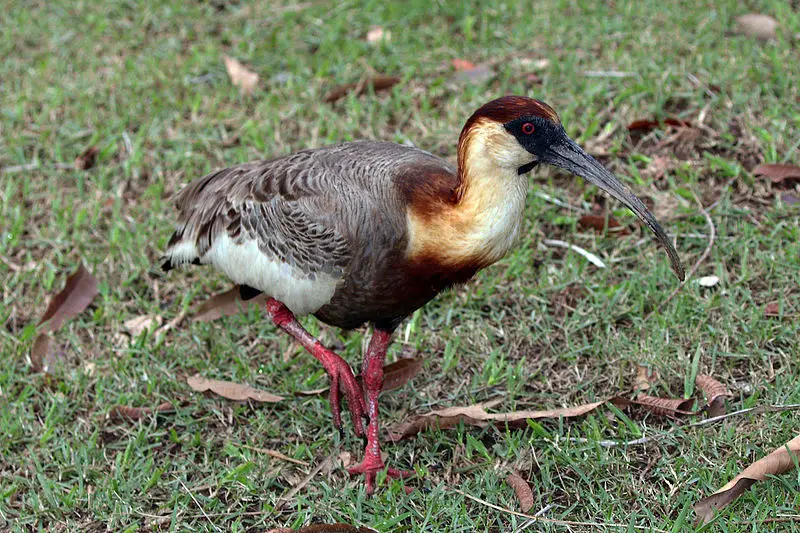
The Buff-necked Ibis is a large bird found in eastern and northern South America. It has grey plumage, with an orange beak and legs, as well as a distinctive white throat.
This striking ibis was previously considered to include the Black-faced Ibis as a subspecies but they have since been recognised as separate species.
The latter having mostly remained at colder regions of South America and featuring buff (not dark grey) lower chest feathers instead.
This bird prefers open habitats such as grasslands, savannahs or marshy areas where it feeds on small insects, lizards or other invertebrates that live among vegetation.
Despite its wide range distribution throughout much of South America this species remains vulnerable due to habitat destruction for agricultural activities which reduces their available food sources significantly.Scientific classification:
| Kingdom | Animalia |
| Phylum | Chordata |
| Class | Aves |
| Order | Pelecaniformes |
| Family | Threskiornithidae |
| Genus | Theristicus |
| Species | T. caudatus |
Also Featured In: Birds that Live in Guyana,
42. Common Miner
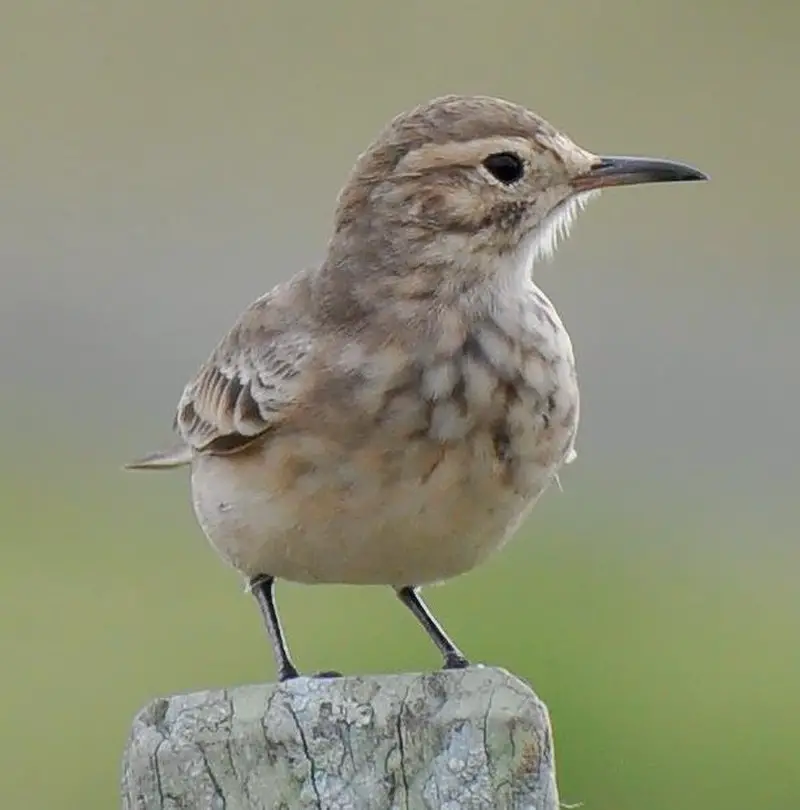
The Common Miner is a small, ground-dwelling bird that can be found in South America. It belongs to the Ovenbird family and has around 9 subspecies.
This passerine bird measures between 14 to 16 cm long with its slightly downcurved bill being quite prominent.
Its plumage varies from region to region but generally it appears brown above and light grey below, with some darker streaks on its breast area for contrast.
It feeds mainly on insects and seeds which it finds while foraging amongst leaf litter or short grasses; often scratching away at the soil in search of food items beneath the surface as well.
With their fluttering wings they make quick work of covering large distances across open terrain looking for tasty morsels.Scientific classification:
| Kingdom | Animalia |
| Phylum | Chordata |
| Class | Aves |
| Order | Passeriformes |
| Family | Furnariidae |
| Genus | Geositta |
| Species | G. cunicularia |
43. Maguari Stork
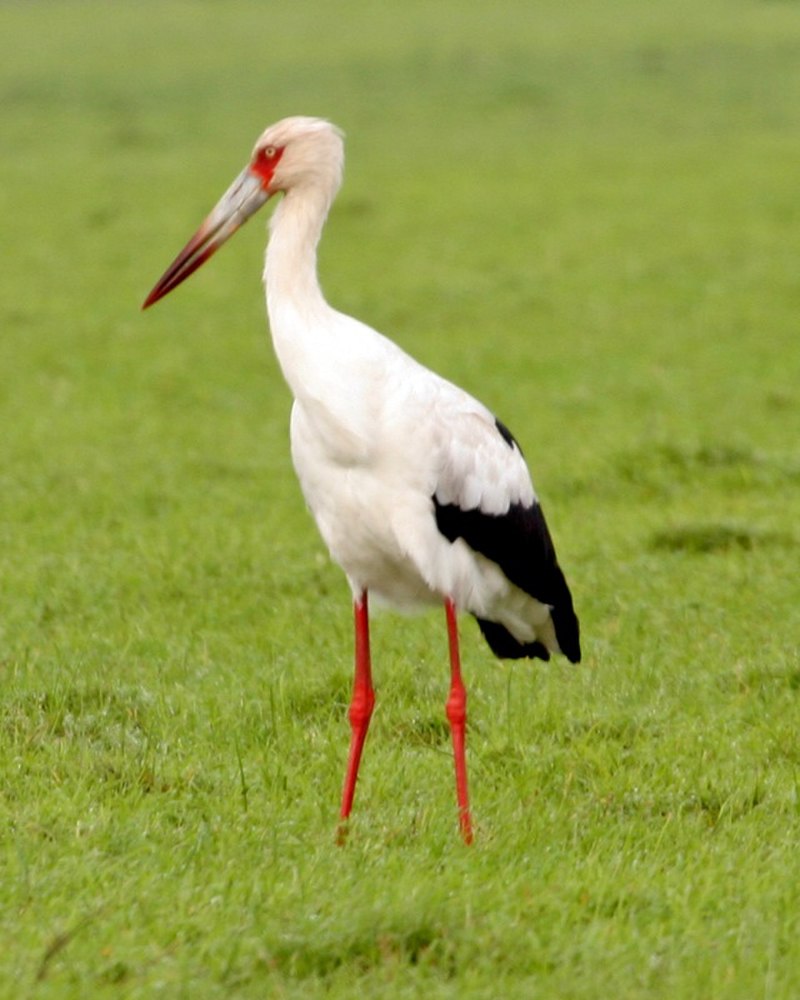
The Maguari stork is a large species of stork found in South America. It has similar features to the white stork, but it is slightly larger.
This bird can be identified by its black body with white patches on its wings and tail feathers and yellow legs which contrast against its dark feathers.
The maguari feeds mainly on fish, amphibians, reptiles, crustaceans and insects; they will also scavenge for food when necessary.
These birds breed during wetland seasons where their nests are made up of sticks or reeds built high above the ground in trees near water bodies such as rivers or swamps.
Their populations have been decreasing due to habitat loss from human activities such as agricultural expansion or deforestation however conservation efforts are being put into place to help protect this unique species so that we may continue enjoy watching these magnificent birds soar through our skies.Scientific classification:
| Kingdom | Animalia |
| Phylum | Chordata |
| Class | Aves |
| Order | Ciconiiformes |
| Family | Ciconiidae |
| Genus | Ciconia |
| Species | C. maguari |
44. Tropical Screech Owl
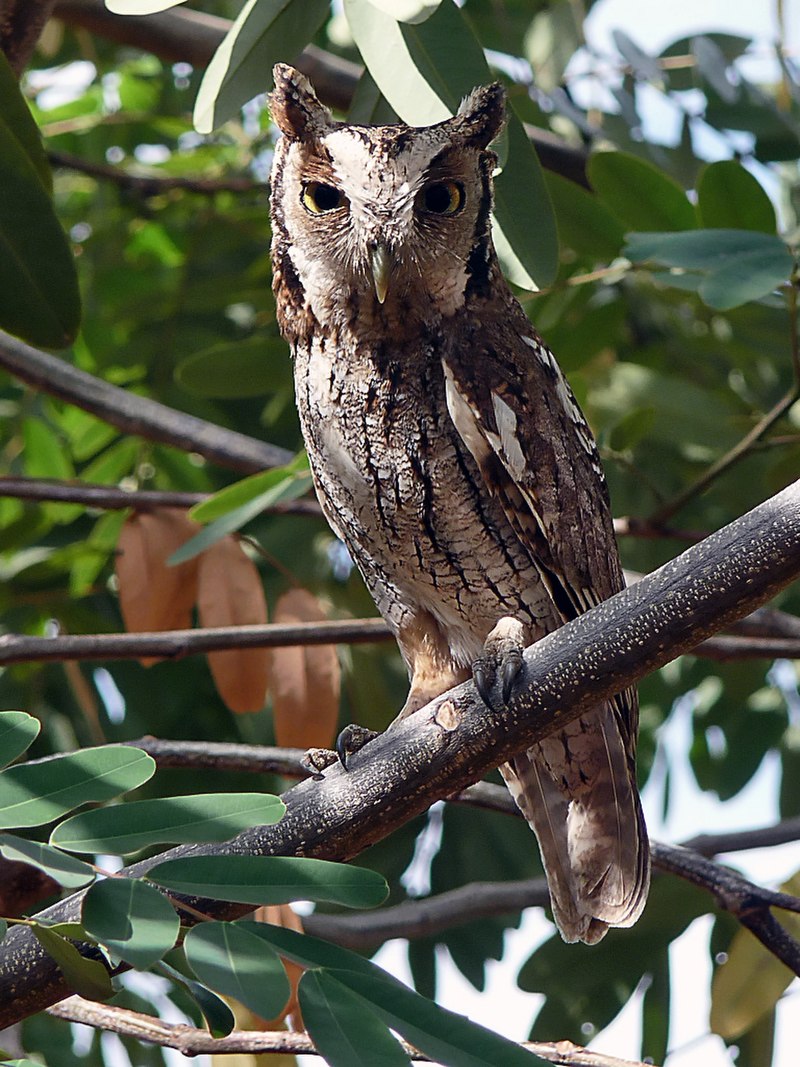
The Tropical Screech Owl is a small bird belonging to the family Strigidae, which can be found in Costa Rica, Panama, Trinidad and all mainland South American countries.
They are known for their unique plumage consisting of gray facial disc with whitish eyebrows along with yellow-orange eyes.
Their wings have varying shades of browns, grays and tawny colors that help them blend into their environment seamlessly.
Taxonomic studies show that they are closely related to White-throated Screech Owls (M. albogularis) and Koepcke’s screech owls (M. koepckeae).
The Tropical Screech Owl is mostly active at night when it hunts by perching on tree branches or flying low over land searching for prey such as insects or mice using its powerful talons to capture them swiftly without much effort.Scientific classification:
| Kingdom | Animalia |
| Phylum | Chordata |
| Class | Aves |
| Order | Strigiformes |
| Family | Strigidae |
| Genus | Megascops |
| Species | M. choliba |
45. Golden-Winged Cacique
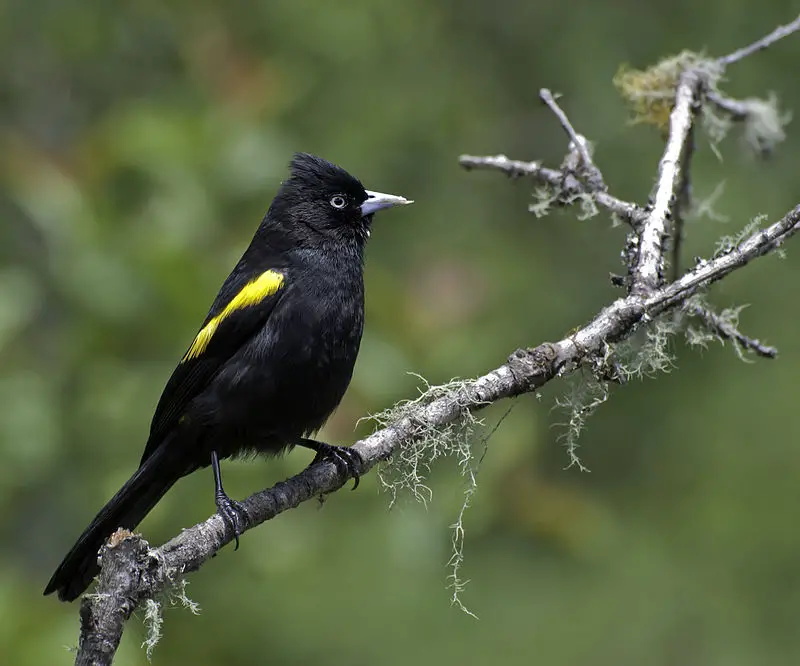
The golden-winged cacique is an impressive species of bird that belongs to the Icteridae family.
It can be found in many South American countries such as Argentina, Bolivia, Brazil, Paraguay and Uruguay living mainly in subtropical or tropical moist lowland forests and montane forests.
This colorful bird has a bright yellow head with black wings which give it its name “Golden-winged”.
The male also features some red patterns on its back while the female is slightly more dull colored than males.
They live around small water sources like swamps and wetlands where they feed off insects and fruits found near them.
While this species faces no major threats at present, their population may suffer if the habitat destruction continues due to deforestation or other human activitiesScientific classification:
| Kingdom | Animalia |
| Phylum | Chordata |
| Class | Aves |
| Order | Passeriformes |
| Family | Icteridae |
| Genus | Cacicus |
| Species | C. chrysopterus |
46. Freckle-Breasted Thornbird
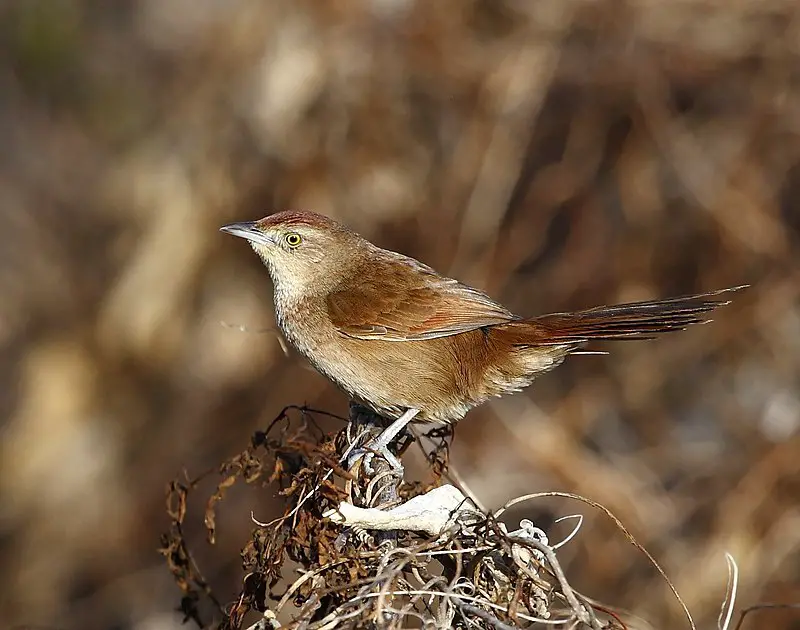
The Freckle-breasted Thornbird is a species of bird found in Argentina, Bolivia, Brazil, and Uruguay. It inhabits moist lowland forest areas as well as dry shrublands and can be identified by its distinctive freckles on its breast.
First described by Alcide d’Orbigny and Frédéric de Lafresnaye in 1838, the bird has an olive-brown coloration with darker brown scalloping along their back.
They have long wingspan measuring up to 16 inches long which enables it to fly relatively fast over distances foraging for food such as insects or small invertebrates from trees or ground level habitats.
In addition they also feed on fruits like berries when available during different times of the year depending upon weather conditions making them quite adaptive birds that are able to survive in diverse climates across South America.Scientific classification:
| Kingdom | Animalia |
| Phylum | Chordata |
| Class | Aves |
| Order | Passeriformes |
| Family | Furnariidae |
| Genus | Phacellodomus |
| Species | P. striaticollis |
47. Grey-Breasted Martin
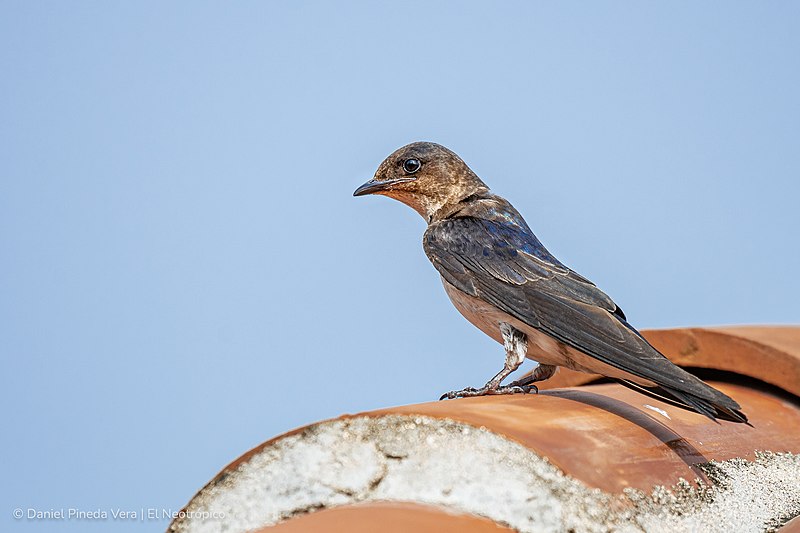
The grey-breasted martin is a large swallow species, native to Central and South America. It has several subspecies, with some migrating north as far as Venezuela during the southern hemisphere’s winter season.
Adults of this species are 18cm long and have forked tails. They mainly feed on insects in open habitats such as savannas or grasslands, but can also be seen near human settlements or agricultural areas.
The birds usually build their nests under bridges or other man-made structures like eaves of buildings or porches where they stay safe from predators.
Grey-breasted martins form monogamous pairs that remain together throughout the year; both male and female take part in nest building activities along with feeding young ones once hatched out of eggs laid by females alone typically laying three to four white eggs per clutch..Scientific classification:
| Kingdom | Animalia |
| Phylum | Chordata |
| Class | Aves |
| Order | Passeriformes |
| Family | Hirundinidae |
| Genus | Progne |
| Species | P. chalybea |
Also Featured In: Most Common Oaxaca Birds, Cozumel Birds You Didn’t Know
48. Rufous-Collared Sparrow
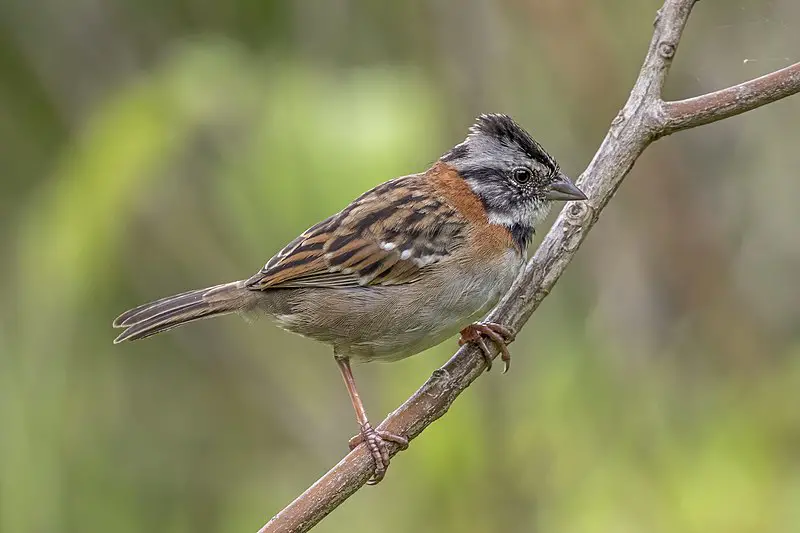
The Rufous-collared Sparrow, also known as the Andean sparrow, is a common bird found in open habitats from Mexico to Tierra del Fuego.
It has distinctive brown and white streaks on its back, with a reddish collar around its neck.
This species can be heard singing throughout much of the year and their vocalizations have been studied extensively since the 1970s.
They are omnivorous birds that feed mainly on seeds but will also consume insects for protein during breeding season.
The Rufous-collared sparrow often lives near humans and is an important part of many ecosystems across South America due to its role in helping disperse plant seeds including those used by people for food or livestock fodder production.Scientific classification:
| Kingdom | Animalia |
| Phylum | Chordata |
| Class | Aves |
| Order | Passeriformes |
| Family | Passerellidae |
| Genus | Zonotrichia |
| Species | Z. capensis |
Also Featured In: Most Common Birds in South America Birds,
49. Chestnut Seedeater
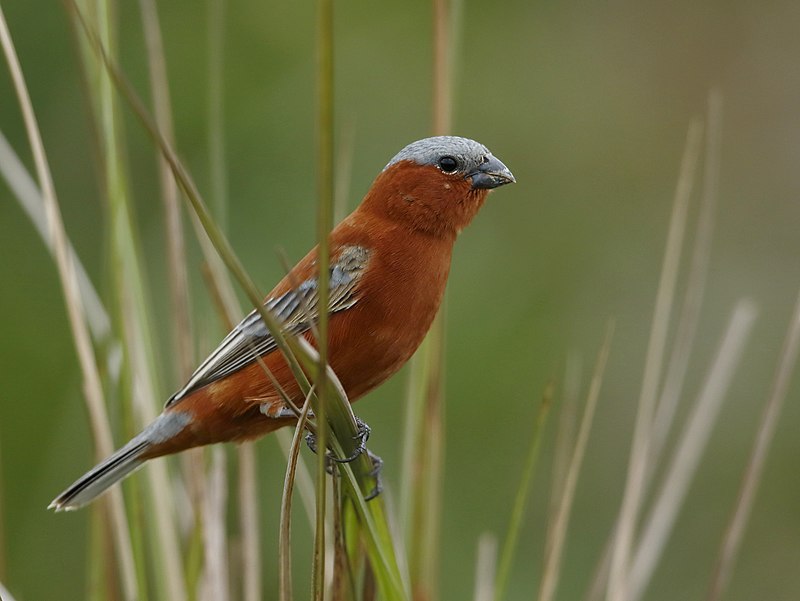
The Chestnut Seedeater is a species of bird belonging to the family Thraupidae. It is found mostly in South America, particularly Argentina, Brazil, Paraguay and Uruguay – where it can still be observed at Quebrada de los Cuervos.
This bird typically inhabits subtropical or tropical seasonally wet lowland grasslands but its population has been significantly impacted by habitat loss due to human activities such as deforestation and land conversion for agricultural purposes.
As a result, this species is now considered threatened and conservation efforts are needed if we want future generations to continue seeing them in their natural habitats.Scientific classification:
| Kingdom | Animalia |
| Phylum | Chordata |
| Class | Aves |
| Order | Passeriformes |
| Family | Thraupidae |
| Genus | Sporophila |
| Species | S. cinnamomea |
50. Royal Tern
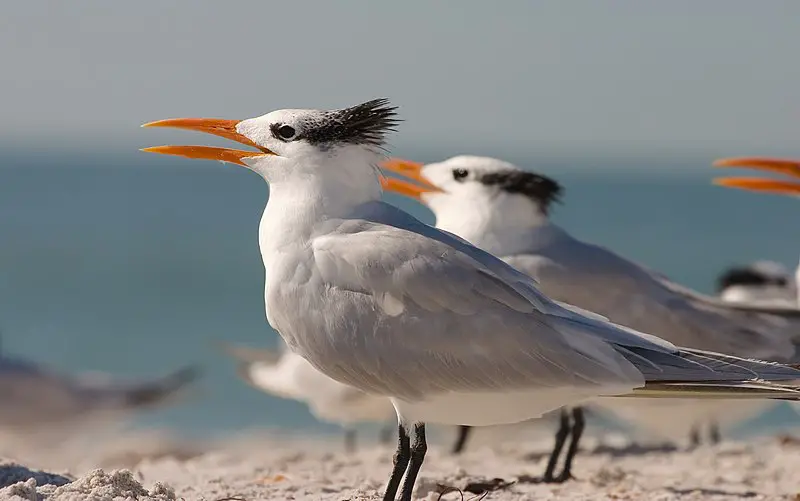
The Royal Tern is a beautiful seabird, endemic to the Americas. It has been spotted as far away as Europe on rare occasions though.
The species was first described by Georges-Louis Leclerc in 1781 from a specimen found in French Guiana and later illustrated with hand-coloured plates.
These birds have elaborate courtship displays that involve loud vocalizations and energetic aerial acrobatics.
They typically mate for life, nesting together near marshes or beaches each season close to their food source of fish and other small aquatic creatures. Their white plumage brightens up coastlines across America – they are truly majestic.Scientific classification:
| Kingdom | Animalia |
| Phylum | Chordata |
| Class | Aves |
| Order | Charadriiformes |
| Family | Laridae |
| Genus | Thalasseus |
| Species | T. maximus |
Also Featured In: Summer Birds that Live around Us, Caribbean Birds